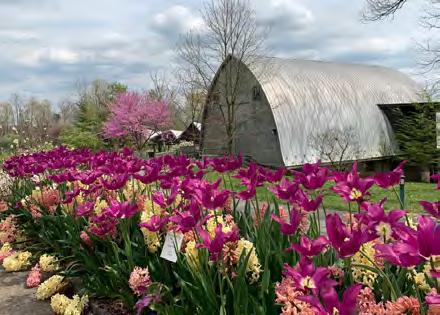Kentucky Settlements
Observe 250


Kentucky Settlements
Observe 250

Profile of a Racetrack Chaplain

Handcrafted bourbon, graceful Saddlebred horses, and iconic Southern comfort food perfected by Colonel Sanders himself. Designer shopping and luxurious places to stay. Close to the city without being in the city and full of small town charm. Paired with our authentic Southern hospitality, it’s easy to see why ShelbyKY is known as Your Bourbon Destination™ and the Saddlebred Horse Capital of the World. In other words, ShelbyKY is everything you love about Kentucky
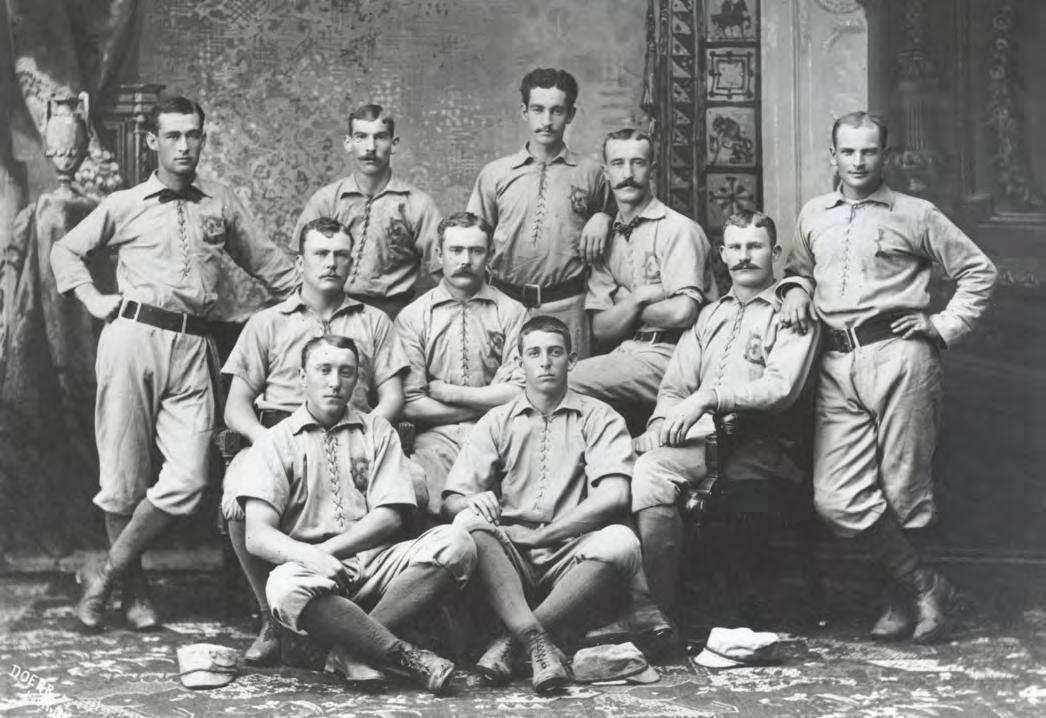

30 Milestone Celebrations Stanford, Fort Boonesborough and Lexington observe their 250th anniversaries
36 Baseball in the Bluegrass State Kentucky has hosted professional baseball since the dawn of the major leagues
42 A National Celebrity The Marquis de Lafayette is feted on the 200th anniversary of his farewell tour of America
Test your knowledge of our beloved Commonwealth. To find out how you fared, see page 6.
1. When was the first Kentucky Derby broadcast nationally?
A. 1948
B. 1952
C. 1956
2. How much did the least expensive Kentucky Derby winner cost?
A. $1,200
B. $12,000
C. $120,000
3. Which filly posted the most impressive winning margin in the Kentucky Oaks?
A. CatchCathy
B. Rachel Alexandra
C. Girl Named Jac
4. How long is a length in horse racing?
A. 8 feet
B. 10 feet
C. 12 feet
5. The winning horse in the Kentucky Derby wears a blanket of 554 roses on a green-satin backing. It is produced by which local company?
A. Nanz and Kraft Florists
B. Oberer’s Flowers
C. Kroger
6. What letter begins the names of more Kentucky Derby-
winning horses than any other?
A. B
B. M
C. S
7. Today’s Kentucky Derby field is usually 20 horses. What is the smallest number of horses ever to run in a Derby?
A. 3
B. 5
C. 7
8. At 18, Walton’s Steve Cauthen was the youngest jockey to win the Triple Crown. Who was the oldest?
A. Eddie Arcaro
B. Mike Smith
C. Pat Day
9. The 1949 Kentucky Derby glass features which icon, who had “seen them all,” beginning with his first Derby in 1875 at 14?
A. Colonel Matt Winn
B. Harry Payne Whitney
C. Meriwether Lewis Clark Jr.
10. Kentucky Oaks attendees are asked to wear pink in support of which cause?
A. Lung cancer research
B. The fight against breast cancer and ovarian cancer
C. Cystic fibrosis

© 2025, VESTED INTEREST PUBLICATIONS VOLUME TWENTY-EIGHT, ISSUE 3, APRIL 2025
Stephen M. Vest Publisher + Editor-in-Chief
Hal Moss Associate Publisher + Business Editor
Patricia Ranft Associate Editor
Rebecca Redding Creative Director
Deborah Kohl Kremer Assistant Editor
Ted Sloan Contributing Editor
Cait A. Smith Copy Editor
Jackie Hollenkamp Bentley, Jack Brammer, Bill Ellis, Steve Flairty, Gary Garth, Jessie Hendrix-Inman, Mick Jeffries, Kim Kobersmith, Brigitte Prather, Walt Reichert, Tracey Teo, Janine Washle and Gary P. West
Barbara Kay Vest Business Manager
Katherine King Circulation Assistant
Lindsey Collins Senior Account Executive and Coordinator
Kelley Burchell Account Executive
Kristina Dahl Account Executive
Laura Ray Account Executive
Teresa Revlett Account Executive
For advertising information, call 888.329.0053 or 502.227.0053
KENTUCKY MONTHLY (ISSN 1542-0507) is published 10 times per year (monthly with combined December/ January and June/July issues) for $25 per year by Vested Interest Publications, Inc., 100 Consumer Lane, Frankfort, KY 40601. Periodicals Postage Paid at Frankfort, KY and at additional mailing offices.
POSTMASTER: Send address changes to KENTUCKY MONTHLY, P.O. Box 559, Frankfort, KY 40602-0559. Vested Interest Publications: Stephen M. Vest, president; Patricia Ranft, vice president; Barbara Kay Vest, secretary/treasurer. Board of directors: James W. Adams Jr., Dr. Gene Burch, Gregory N. Carnes, Barbara and Pete Chiericozzi, Kellee Dicks, Maj. Jack E. Dixon, Bruce and Peggy Dungan, Mary and Michael Embry, Judy M. Harris, Greg and Carrie Hawkins, Jan and John Higginbotham, Frank Martin, Bill Noel, Walter B. Norris, Kasia Pater, Dr. Mary Jo Ratliff, Randy and Rebecca Sandell, Kendall Carr Shelton and Ted M. Sloan.
Kentucky Monthly invites queries but accepts no responsibility for unsolicited material; submissions will not be returned.
KENTUCKYMONTHLY.COM


Such a fun read in the February edition, “As the Old Saying Goes …” (page 60).
Bill Ellis has a couple of years on me, but “I am singing the same tune” when it comes to “rolling the dice” right up to the day I “cash it in.” I have a close friend who lives by the principle of “quality of life, rather than quantity!” He admits his daily shots of Pappy Van Winkle 15 contribute to high blood pressure and may shorten his life but “so be it.” His “end of the trail” will be the Kentucky Bourbon Trail.
When I turned the big 8-0, I went for my annual wellness exam and proceeded to “sing the blues” to my doc as to this hurt, that hurt, and that it takes me 5 minutes just to put on my socks!
I “tucker out” faster than I used to but still feel “fair to middlin’.” My doc told me, “Mr. Ward, life expectancy is around 76 to 77 … You are playing with house money!” So, “let the good times roll” even if we are “over the hill!”
Jerry Ward, born in Erlanger, now living in Yakima, Washington
Bill Ellis’ article on evolution in the March issue (page 56) was not only excellent writing but
also nostalgic. I’m preparing for a talk in Paducah on the Scopes Monkey Trial.
We recognize the 100th anniversary of that trial this summer. As Bill noted, John Scopes was from Paducah.
I also appreciated Bill’s comments about growing up in the Baptist church. I especially like that he shares with me a great pride in our faith and “will die a Baptist.” After rummaging around in my attic of beliefs for much of my life, I’ve concluded that Mama got it right in making us virtually live in the Baptist church growing up. (My father tagged along.)

Keep writing. Zoraster said, “If it is written, it will be remembered. If it is remembered … it will live.”
Bill Cunningham, Frankfort
We Love to Hear from You! Kentucky Monthly welcomes letters from all readers. Email us your comments at editor@kentuckymonthly.com, send a letter through our website at kentuckymonthly.com, or message us on Facebook. Letters may be edited for clarification and brevity.


Kentucky Monthly’s annual gift guide highlights some of the finest handcrafted gifts and treats our Commonwealth has to offer.

Even when you’re far away, you can take the spirit of your Kentucky home with you. And when you do, we want to see it!


Glema Daniels Layne of Betsy Layne (Floyd County); Chuck Conway of Leesburg, Florida; and Joan Daniels Chaffins of Clarksville, Tennessee, met up for a cousins’ get-together at the annual GeorgeFest at Ferran Park in Eustis, Florida.
Vanda Galen, of Mankato, Minnesota, and Elaine Palencia and Michael Palencia-Roth of Champaign, Illinois, took their favorite issue of Kentucky Monthly, featuring bourbon and Chris Stapleton, on a cultural tour of Havana, Cienfuegos and Trinidad de Cuba. Elaine and Vanda grew up in Morehead and were celebrating 73 years of friendship. They met when they became nextdoor neighbors at age 5.
Take a copy of the magazine with you and get snapping! Send your high-resolution photos (usually 1 MB or higher) to editor@kentuckymonthly.com or visit kentuckymonthly.com to submit your photo. submit your photo

Frank Kirschner, a 1973 University of Kentucky graduate in journalism and a Wildcat football player, is pictured in The Villages, Florida. A freelance writer and author, he lives in West Palm Beach.






Philip and Debbie Ingber (center) of Richmond, along Jacqueline Berman (second from left) and family of Washington, D.C., paid a visit to the iconic and majestic Versailles, France.
1. B. 1952, won by Eddie Arcaro aboard Hill Gail; 2. A. The 1971 winner Canonero II sold for $1,200 at the 1969 Keeneland September Yearling Sale; 3. B. Rachel Alexandra won by 20¼ lengths in 2009 and, in her next start, scored in the Preakness Stakes, the second leg of the Triple Crown, before finishing a stellar season and being named 2009 Horse of the Year; 4. A. Based on the length of a horse from head to tail, roughly 8 feet; 5. C. The blanket has been made at the Kroger in Middletown since 1987; 6. C. Secretariat, Seattle Slew and Silver Charm are just three of the 19 winners with “S” names; 7. A. Only three horses ran in the 1892 and 1905 races; 8. B. Mike Smith was 52 when he won the Triple Crown aboard Justify in 2018; 9. A. Ironically, Winn, who is credited with making the Derby famous, died later that year; 10. B. The Friday event generally draws more than 100,000 fans to Churchill Downs.
March Kwiz corrections:
n Jessie D. “J.D.” Presley, Elvis’ grandfather, died on April 19, 1973 (question 10). So, when “The King” played at the Jefferson Country Armory in Louisville in 1956, he visited J.T. at his home in Iroquois Park Neighborhood.
n The county seat of Ballard County is Wickliffe (question 7) and has been since the county seat in Blandville burned in 1880.

highly competitive, and, yes, professional, with many players hungry for an MLB shot, while others just want to keep playing the game they love!
Question: The Legends are celebrating their 25th anniversary in Lexington. What special promotions are planned for this year?
Answer: Alongside our regular promotions, we have got plenty of exciting plans for our 25th anniversary! Expect throwback jerseys, a Players Reunion Weekend in June, exclusive commemorative giveaways, and bobbleheads. It’s going to be an action-packed season!
Q. Who are some of the top Legends alumni who went on to successful MLB careers?
A. Jose Altuve, Hunter Pence, Ben Zobrist, Kike Hernandez, J.D Martinez, Brandon Phillips—I mean, the list goes on. We’ve been fortunate to have such notable names come through this organization.
Q. The Legends will be competing in the Atlantic League, which is considered the best independent baseball league. Can you explain to our readers the difference between an MLB-based minor league team and the Atlantic League teams?
A. MLB minor league teams are affiliated with major league clubs, these are the guys feeding right into the MLB. The Atlantic League teams are independent—meaning we aren’t affiliated with any MLB team, still
Q. What brings you the most satisfaction running a minor league baseball organization?
A. As general manager for the Lexington Legends, the most satisfying part of running the organization is creating lasting memories for families that will be cherished for a lifetime. It’s about building a place where fans can gather, cheer and experience the joy of baseball together. I’m also proud to help lay the foundation for our staff, watching them grow and progress in their careers. But it’s not just about the game—it’s about staying deeply involved in the Lexington community and building a brand that the entire city can call its own. That sense of pride and connection is what makes this work truly fulfilling.
Q. Tell us a little about your background. How did you decide or happen upon a career in baseball management?
A. At 18 years old, I was diagnosed with testicular cancer, and it was actually during a baseball game that I first discovered something was wrong. Going through that experience was life-changing, and it gave me a new perspective on the game and the importance of community. Baseball, and the support I received from those around me, played a huge role in
helping me get through that tough time. It’s what inspired me to give back to the game and the community that truly saved my life. This is why I’m so passionate about being the general manager of the Lexington Legends—it’s about creating those same meaningful connections and giving back to a sport and a community that means so much to me.
Now a couple of fun/personal questions:
Q. What do you like to do for relaxation? Or describe your perfect day?
A. Ah, great questions! I enjoy driving my Jeep down some backroads with the doors and roof off, going to concerts and, believe it or not, attending sporting events. Most importantly, I enjoy spending time with my wife and family!
Q. If you could invite three guests for dinner, past or present, who would they be?
A. Derek Jeter, Kobe Bryant and my dad.
For a history on baseball in Kentucky, see page 7.
Periodically, we pose questions to a prominent Kentucky business leader and publish them along with the responses. Got Business News to Share? Contact Business Editor Hal Moss at hal@ kentuckymonthly.com with press releases or business news.

Spring heralds Easter, and soon after, the Kentucky Derby is just around the bend. These flexible recipes present a lovely brunch, but with the addition of a breakfast
item such as a pastry tray, it becomes a leisurely breakfast. Switch out the breakfast dishes for a savory side, and this brunch menu becomes a delightful lunch.
You can count on this varied menu to add a splash of Kentucky flavors to your spring functions.
JANINE WASHLE
8 large eggs
½ cup whole milk
½ teaspoon sea salt
1 tablespoon butter
2 teaspoons olive oil
1 cup fresh baby spinach
½ cup diced onions
¼ cup chopped crispy bacon
¼ cup crumbled feta
2 tablespoons minced fresh parsley
¼ teaspoon granulated garlic
1/8 teaspoon nutmeg
Garnish: ½ teaspoon lemon zest, 2 tablespoons crushed almonds, 1 small minced garlic clove and 2 teaspoons minced fresh parsley stirred together.
1. Preheat oven to 375 degrees.
2. In a large bowl, whisk together eggs, milk and salt. Set aside.
3. In a large cast-iron or other ovenproof skillet set over medium heat, warm butter and olive oil until butter is melted. Add spinach, onions, bacon, feta, parsley, garlic and nutmeg to skillet and stir until spinach is wilted and bright green. Spread this mixture out across pan.
4. Pour egg mixture over top. Cook for 5 minutes or until eggs bubble around edges of pan.
5. Using heat-proof gloves, carefully transfer skillet to oven.
6. Bake for 25-30 minutes or until center is puffy and loses its wet sheen. Remove from oven to a cooling rack to rest for 10 minutes.
7. To serve, sprinkle garnish mix over the top of the frittata. Slice into wedges. Can be served at room temperature. Store leftovers in refrigerator.
MAKES APPROXIMATELY 12 CREPES
1 cup all-purpose flour
2 tablespoons sugar
¼ teaspoon salt
3 large eggs
1¼ cups whole buttermilk
¼ cup water
2 tablespoons unsalted butter, melted (plus more for greasing pan)
Warm strawberry compote, recipe follows
Powdered sugar
Whipped cream
1. In a medium bowl, whisk together the flour, sugar and salt.
2. In a second large bowl, whisk eggs, buttermilk and water until combined. Gradually add the wet ingredients to the dry ingredients, whisking until smooth. Stir in melted butter.
3. Let the batter rest at least 30 minutes or refrigerate overnight for better results.
4. Heat a nonstick 6-inch skillet or crepe pan over medium heat and lightly grease with butter. Pour about ¼ cup of batter into the center of pan. Swirl batter quickly in a clockwise rotation to coat the bottom evenly (if left-handed, rotate clockwise; if righthanded, counterclockwise).
5. Cook 1-2 minutes until the edges start to lift and the bottom is lightly golden. Flip and cook for another 30 seconds. Repeat steps 4 and 5 with the rest of the batter.
6. Stack finished crepes on a plate and cover with a clean towel to keep warm.

7. To serve, lay a crepe on a flat surface. Put a spoonful of compote in the center toward bottom of crepe. Roll up and place on a large serving plate. Continue until all crepes are filled and rolled. Serve any remaining compote on the side.
8. Sprinkle crepes with powdered sugar and dollops of whipped cream down the center.
Warm Strawberry Compote
1 quart (4 cups) fresh strawberries, washed, with large ones halved
½ cup granulated sugar
¼ cup orange juice
1 teaspoon fresh orange zest
1. Combine strawberries, sugar, orange juice and zest in a medium saucepan set over medium-high heat. Bring to a boil, then reduce heat to a gentle simmer.
2. Cook until strawberries are tender but still retain shape, about 8-10 minutes. If liquid isn’t reduced enough to coat the back of spoon, strain out berries to a serving bowl. Turn heat to high and boil about 3-5 minutes or until liquid coats the back of a metal spoon.
3. Pour reduction over strawberries.
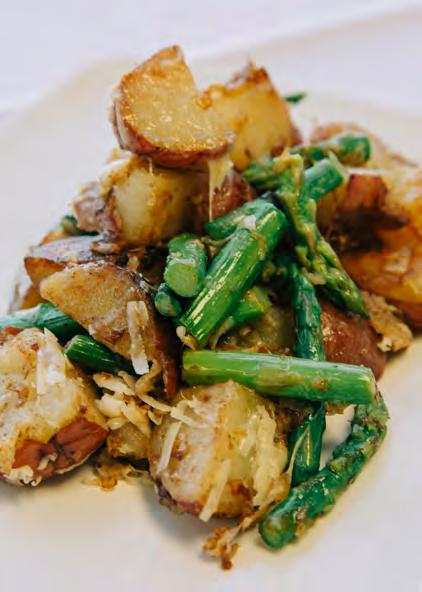
SERVES 6-8
3 tablespoons butter
3 cups roasted baby red potatoes
1 bunch fresh asparagus, washed, trimmed, cut in thirds
1 teaspoon minced garlic
¼ cup grated Parmesan
1 teaspoon lemon zest
Salt and pepper to taste
1. Melt butter in a large sauté pan. Add roasted potatoes and sauté until warm. Add asparagus and garlic. Toss to combine.
2. Continue to cook until asparagus spears are bright green and fork tender, about 8 minutes. Stir in Parmesan, lemon zest, salt and pepper.
3. Serve immediately. Store any leftovers in refrigerator in a covered container.
SERVES 10-12
12-pound bone-in ham
½ cup apricot fruit spread
¼ cup dark corn syrup
¼ cup granulated sugar
2 tablespoons lemon juice
1 tablespoon ground mustard
¼ teaspoon ground cloves
1 cup pecan pieces

1. Preheat oven to 325 degrees.
2. Line a roasting pan with heavy-duty foil.
3. Create a diamond pattern on ham by using a thin-bladed sharp knife, scoring diagonally one direction, and then scoring in the opposite direction to create the pattern. Place in oven and bake while beginning glazing process.
4. While ham is baking, prepare the glaze by pouring apricot fruit spread, dark corn syrup, sugar, lemon juice, mustard and cloves in a medium-sized pot set over medium-high heat. Stir occasionally until the brown sugar begins to dissolve and the sauce starts bubbling, about 7 minutes. Stir in pecan pieces. Set aside until needed.
5. After 50 minutes of baking the ham, remove it from oven and spoon half of the glaze over it, carefully spreading mixture into all the nooks and crannies. Place pan back in oven and continue to bake ham for 15 minutes. Once again, remove ham from oven and re-glaze with remaining mixture. Return ham to oven and bake an additional 15 minutes.
6. Remove ham from oven and set on heatproof surface to rest for 15 minutes. Spoon any glaze and accumulated juices that ended up in the bottom of the pan over the ham.
7. To serve, use a long sharp knife to slice portions approximately ¼-inch thick and place on serving plate. The ham is good warm, at room temperature, and even cold.


Recipes provided by Janine Washle of The Flavor Queen’s Kitchen in Clarkson (flavor-queen. com), prepared at Sullivan University by Chef John Foster, and photographed by Rebecca Redding.
ABBEY COOPER
ACCOUNTING
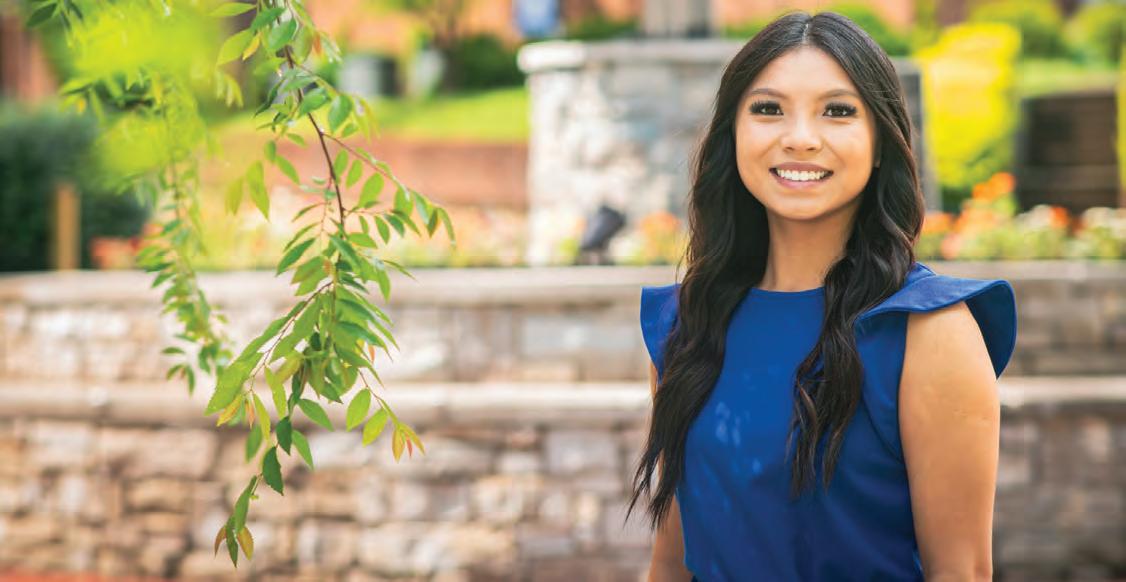


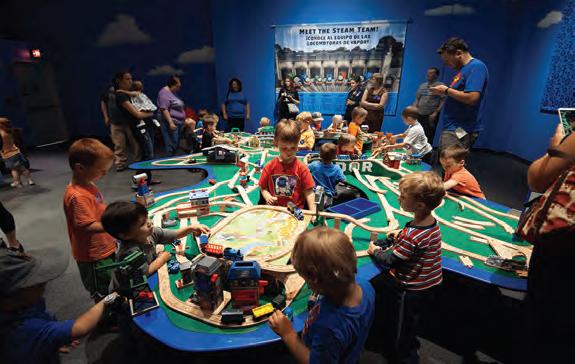
Churchill Downs chaplain Pável Urruchi’s ministry extends well beyond the racetrack’s chapel
TEXT AND PHOTOS BY KEN SNYDER
For Pável Urruchi, racetrack chaplain at Churchill Downs, his world is bigger than one might imagine. His “flock” is the 1,000 people who work at the barn area—or backside—of the track, 85 percent of whom live there.
Urruchi ministers in a chapel just inside one of the gates into Churchill Downs’ backside, leading a service every Monday night. Backside work at a racetrack is seven days a week, eliminating Sunday morning services.
But Monday is only a part of Urruchi’s ministry. His real ministry is in the shedrows of 46 barns at the racetrack. His “church” is where his congregation lives.
The 2024 Kentucky Derby was his first as chaplain at Churchill Downs since assuming the position in November 2023. On Derby Day morning, Urruchi stopped to talk with every person at several barns.
“It can take me sometimes a whole week to visit all the barns; that’s my goal,” he said. “I try to speak to as many people as I can, including the trainers, and just make sure that they know I’m there for them.”
With an ever-present smile, he said with reluctant shyness, “I would say everybody knows me.” That’s a remarkable feat for the number of people he reaches.
The fruits of his footwork, which
begins at 7:30 each morning, is a congregation that fills the chapel to capacity on Monday nights.
Last year, as Derby Day approached, Urruchi’s regular rounds also included visiting trainers with the good fortune of having a Derby starter. A little-known tradition is that the track chaplain prays individually for Derby trainers the morning of the race. Urruchi will do so for a Derby trainer only if asked.
The requests last year came, not surprisingly, as a result of Urruchi’s standard barn walks, when he introduced himself in the days before the big race to Derby trainers and volunteered to come by their barn on

the morning of the big race.
During the meet, Urruchi goes to the jockeys’ quarters on the frontside of Churchill Downs on race days. “I spend time with them from an hour before the first race all the way to the fourth or fifth race,” he explained.
He prays with all the riders for safety that day and then stays to talk to them individually, as he does with the barn workers. “I’m grateful that sometimes, when a jockey has a need to talk, I’m there,” Urruchi said.
He mentioned that riders have stress aside from safety concerns. They must secure mounts in a competitive jockey colony and, of course, are under pressure to win races. But sometimes, they keep this stress under wraps. “Jockeys are not going to be telling you how they feel

always,” Urruchi said.
Urruchi is sensitive to what he hears in private conversations with riders, and he can refer a jockey to a mental health institution that partners with Churchill Downs for a free assessment and counseling if needed.
Derby 150 was no different than any other race day for Urruchi, with prayer with the jockeys before the first race. A highlight for him was the observance of another tradition: prayer with the 20 Derby jockeys later that day before the big race.
Even with a full schedule, Urruchi desires to expand use of the chapel beyond Monday evenings, especially in the two weeks leading up to the Derby, when media members and
Derby starters with their entourages begin arriving. This idea is in response to visitors asking about any events at the chapel during the week. “I’m thinking that the chapel will be open so people can come and pray or just have a moment with me,” he said.
Looking toward Derby 151, the energetic native of Peru said, “I want people to know who we are and why we are there, how we love this place.”
To watch Urruchi visit barns is a testament to his love for the people who work at Churchill Downs and for the racetrack itself.
Urruchi said that love is action, and it goes far beyond brief conversations at barns during the mornings. “We have a clothing closet ministry open twice a week— Mondays and Thursdays. We provide

toiletries, towels, shoes, jeans, blankets, comforters and, sometimes—if there’s a need— mattresses,” he said. “But also, once a week we provide lunch Thursdays for the workers. Everybody’s welcome.”
Additionally, there are both Spanish- and English-language Bible studies for workers.
Another service is help with immigration issues. “We have partnered with a nonprofit organization, Access Justice,” Urruchi said. “They come once a week, and they provide immigration services for free … We want to be a blessing holistically.”
• • •
The challenges at Churchill are larger in terms of numbers than they were at Turfway Park in Florence,
where Urruchi served as track chaplain for nine years. “There hasn’t been a shortage of workers here at Churchill Downs,” he said, reflecting the track’s size and status in racing.
One key advantage for Churchill Downs, Urruchi cited, is housing in a dorm with no rent and paid utilities. “This is why it has an appeal for many people who are new coming to the U.S.,” he said. “Let’s say you’re single, and you just came to the U.S. with no family. Living with friends would cost $300 to $400 a month sharing an apartment.”
The benefits and advantages of working at Churchill Downs spur workers to recruit others from their home countries to come to Louisville if work is available.
The workload is far different from past years, when a groom cared for
three or four horses. Today, grooms handle six or seven horses, according to Urruchi. “People who emigrate from other countries—especially young people—they’re willing to work, and they’ve been working every day on farms or other places. They’re going to continue to work seven days a week,” he said. It is a concern for him.
Over the past few decades, a shift to Hispanic workers on the racetrack comes from a marriage of these factors: more income in the United States than their home countries, a better lifestyle and experience with horses.
The latter isn’t universally true across Central and South American countries. “Venezuelans and Nicaraguans have asylum,” said Urruchi, meaning they can bypass much of the paperwork involved with
legal immigration, but inexperience is an obstacle in working on the racetrack, especially at a place like Churchill Downs.
It is common, though, for immigrants from Mexico, among other nations, to have grown up with horses. They can adapt quickly to the requirements and skills that come with racetrack work. •
Support for the racetrack chaplaincy comes from regular donors, churches in the Louisville community, and nonprofit organizations. Also, a team of volunteers assists Urruchi with the Monday service and events such as the clothing closet.
A key fundraiser is the annual “Race for Grace” sponsored by the Kentucky Racetrack Chaplaincy and held the week before the Derby. The event, which includes an auction of horse-racing memorabilia and a dinner, featured former Heisman Trophy winner Tim Tebow last year. This year’s speaker will be last year’s Derby-winning jockey, Brian “B.J.” Hernandez
Urruchi laughed at a sartorial faux pas he committed on his first Derby weekend: He didn’t wear something pink on Oaks Day. “Man, I didn’t get the memo,” he said with a laugh. “Usually, I’m in jeans, but I did wear some khakis for Derby.” He thinks a suit might be more appropriate this year.
One thing is certain: Apparel notwithstanding, Urruchi is a “fit” for Churchill Downs with a commitment and enthusiasm that go beyond filling up the chapel each week.
“I want to continue to be a light to the people and a resource, a blessing ready to share the hope that we have in Jesus,” he said. Q




BY JACKIE HOLLENKAMP BENTLEY
Now that the brutal winter months are behind us, it’s time to look to spring and its activities. Among those is the Kentucky Derby Festival with its 70-plus planned events throughout the region, all leading up to the 151st running of the Kentucky Derby.
Everything from family fun to exquisite culinary celebrations to road races to fantastic music is in store for festivalgoers. Kentucky Monthly proudly features the official schedule of events in this issue.
The KENTUCKY DERBY FESTIVAL is a private, not-for-profit, community organization dedicated to providing unique entertainment for the Greater Louisville area. One of America’s greatest community celebrations, it is known for its whirlwind of colorful events and programs, and how it brings the community together in celebration every spring. With more than 70 special events, there is something for everyone. More details on the 2025 Festival can be found online at KDF.org, or on social media @KyDerbyFestival. *Schedule subject to change.

This year marks the 70th Kentucky Derby Festival, which also means its founding event, the beloved Pegasus Parade, is marking its 70th trip along Broadway in downtown Louisville.
The festival is celebrating the milestone with the theme “Happy Derby: Pink Out Party!” and transforming the 17-block
parade route into a pink paradise.
“This year marks the parade’s 70th year, and we want to make it even more memorable by encouraging both participants and spectators to show their spring spirit in one of the Festival’s favorite colors and help us paint Broadway pink,” said
Matt Gibson, Kentucky Derby Festival president and CEO.
The parade is Sunday, April 27. Folks can get a sneak peek on April 5 at the Zoeller Pump Company ParadeFest.
“We’re always looking at new ways to celebrate with our Festival fans, and the Zoeller Pump
Company ParadeFest is a fun way for families to experience the Festival,” Gibson said.
The inaugural event will feature a first look at the Pegasus Parade’s inflatables, equestrians, bands, floats and more. More information on this and all of KDF’s 70-plus events can be found at kdf.org

Every year, The Fillies Inc.—a philanthropic volunteer group—hosts a Derby Ball fit for royalty. Since 2008, The Fillies also have offered children from across Kentuckiana the chance to hobnob with Derby royalty as part of the Children’s Tea with Kentucky Derby Festival Princesses.
“In Louisville and the surrounding area of Kentucky, spring is such a fun event for adults, with all the Derby festivities and so many different events kids can enjoy,” said Linda Fulton, chairperson of the event. “But this tea is catered specifically to kids, for kids to get out and have a little bit of Derby fun, a little spring fun and dress up.”
This year’s event, Spring Eggstravaganza, will give children ages 3-8 the opportunity to stroll down a red carpet and enjoy a buffet lunch. (Of course, chicken fingers, mac and cheese, and cupcakes are on the menu.) Other kid-friendly activities include face painting, a scavenger hunt, balloon artists, stilt walkers and a visit from the Easter Bunny.
The highlight of the April 19 event will be meeting the Kentucky Derby Festival Queen and her court of festival princesses.
“They’re all there, and they’re in their gowns, so [the children will] have an opportunity to have pictures taken, and the children also get to have a picture to take home with them that day,” Fulton said.
Tickets are $35 each and can be purchased at acwfillies.wildapricot.org.

APRIL 4 • 4-8PM
Caesars Foundation of Floyd County Kentucky Derby Festival FamFest, Presented by Wellstone Regional Hospital
Floyd County Family YMCA, Downtown New Albany
Family-friendly event with a special preview of the 2025 Festival, featuring inflatables, activities, face painting, bubbles, mini golf and more. First 1,000 attendees receive a custom event pin.
Sponsor: Caesars Foundation of Floyd County. Presenting Sponsor: Wellstone Regional Hospital. Media Sponsor: 102.3 The Rose.
APRIL 5 • NOON-4PM Zoeller Pump Company Kentucky Derby Festival ParadeFest
Zoeller Pump Company
New for 2025. Family-friendly event with a special preview of the Zoeller Pump Company Pegasus Parade featuring inflatables, bands, floats, activities, local food trucks and more.
Sponsor: Zoeller Pump Company. Contributing Sponsor: Kentucky Venues. Official Health Care Provider: UofL Health. Official Hotel: The Galt House Hotel.
APRIL 12
Kentucky Derby Festival Thunder Over Louisville®
FoodFest and Thunder On the Ground open at 11AM. Airshow 3PM. Drone and Night Show 9PM Fireworks 9:30PM
Downtown Louisville Riverfront, Waterfront Park, River Road and Southern Indiana shoreline
Thunder Viewing Areas. Admission is free with a 2025 Pegasus Pin®: North Great Lawn featuring UPS Flight Deck (Opens at 9AM). Thunder Chow Wagon at Waterfront Park and the East River Road Beer Garden (Opens at 11AM). West Belvedere (Opens at 11AM). Meijer Family Fun Zone at the Big Four Bridge Lawn (Opens at 2PM). (No tents, stakes, tape or pets.)
2025 Sponsors: Caesars Southern Indiana, Humana, LG&E, Meijer, UA Local 502 and UPS. Official Health Care Provider: UofL Health. Official Bourbon: Four Roses Bourbon. Official Hotel: The Galt House Hotel. Official Tailgate Sponsor: Lynn Family Stadium. Official Broadcast Partners: WHAS 11 and MIX 106.9.
APRIL 12 • 2:30-10:30PM
Louisville Muhammad Ali International Airport Thunder Over Louisville VIP Rooftop Party, Presented by
Waterside Garage Top
Front-row seat for Thunder Over Louisville. VIP General Admission: $225. Premium Reserved Table of 8: $3,000. Tickets at ThunderOverLouisville.org
Sponsor: Louisville Muhammad Ali International Airport. Presenting Sponsor: Kentucky Proud. Contributing Sponsor: Crushed Ice Catering.
APRIL 19 • 11AM–1PM
The Children’s Tea with The Derby Festival Princesses, Presented by The Fillies, Inc.
Louisville Slugger Field
Meet the Kentucky Derby Festival Queen and Princesses at The Children’s Tea, themed “Spring Eggstravaganza.” Tickets $35 each. Adults accompanying children also need a ticket. Event suggested for children ages 3-8. Produced by: The Fillies, Inc. For more info and tickets, visit acwfillies.wildapricot.org
APRIL 19
Brightside Spring Community-Wide Cleanup
Various locations
Brightside encourages all residents to take part in the Community-Wide Cleanup. All cleanup teams will receive bags and gloves at no cost. Contact Brightside at 502.574.2613 or email Brightside@louisvilleky.gov to participate.
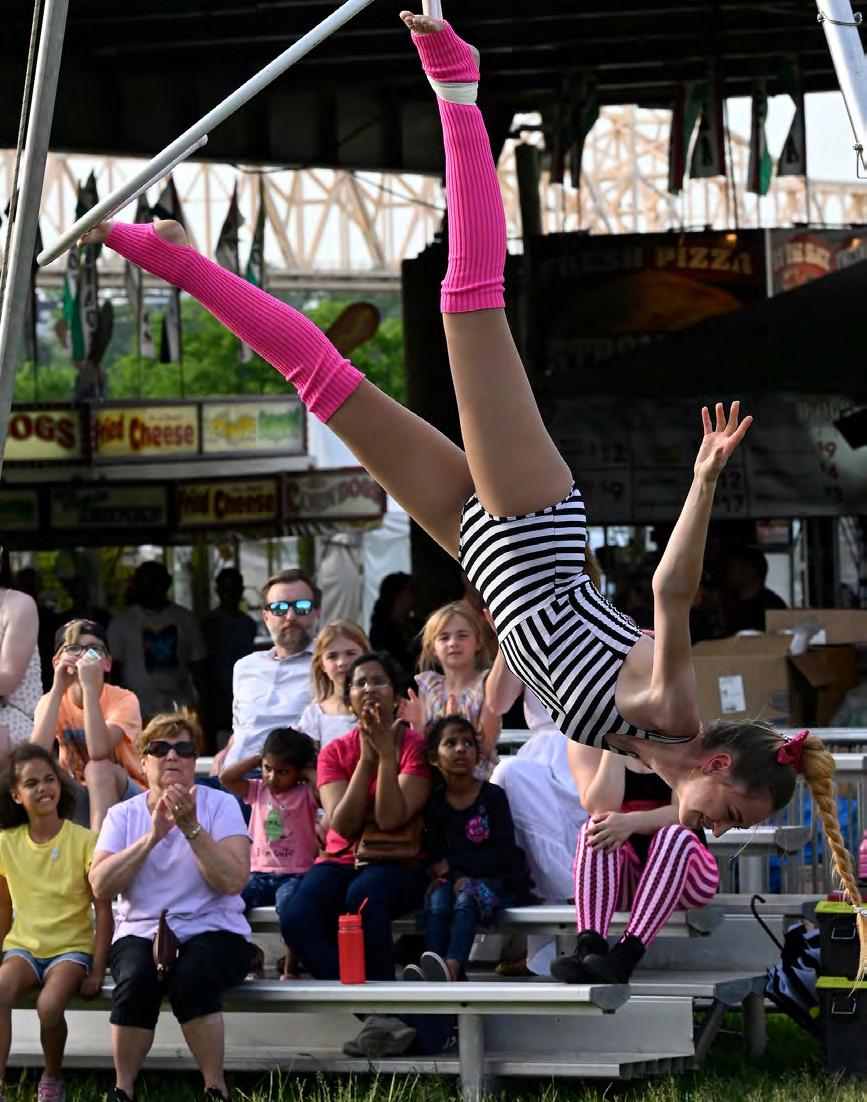
picturesque events. Admission is free with a 2025 Pegasus Pin®.
APRIL 24-26
L&N Federal Credit Union
Kentucky Derby Festival Great BalloonfestSM
Various locations
Four balloon events over three days. Colorful hot air balloons will light up the Louisville skyline during one of the Festival’s most
Sponsor: L&N Federal Credit Union. Contributing Sponsors: AFS Foundation & Waterproofing Specialists, Kentucky Kingdom & Hurricane Bay, Kentucky Tourism, Arts & Heritage Cabinet, Shady Rays and UA Local 502. Official Broadcast Partner: WLKY. Media Sponsor: MIX 106.9.
APRIL 24-25
L&N Federal Credit Union
Kentucky Derby Festival Great Balloon Glow
Kroger’s Fest-a-Ville on the Waterfront
Admission is free with a 2025 Pegasus Pin®. Streamed live on WLKY.com on April 24. Broadcast special on April 26 at 8 PM on WLKY.
Sponsor: L&N Federal Credit Union. Contributing Sponsors: AFS Foundation & Waterproofing Specialists, Kentucky Kingdom & Hurricane Bay, Kentucky Tourism, Arts & Heritage Cabinet, Shady Rays and
APRIL 26 • 7AM LAUNCH
L&N Federal Credit Union Kentucky Derby Festival Great Balloon Race
Bowman Field, Public entrance off Pee Wee Reese Road.
Admission is free with a 2025 Pegasus Pin®.
Sponsor: L&N Federal Credit Union.
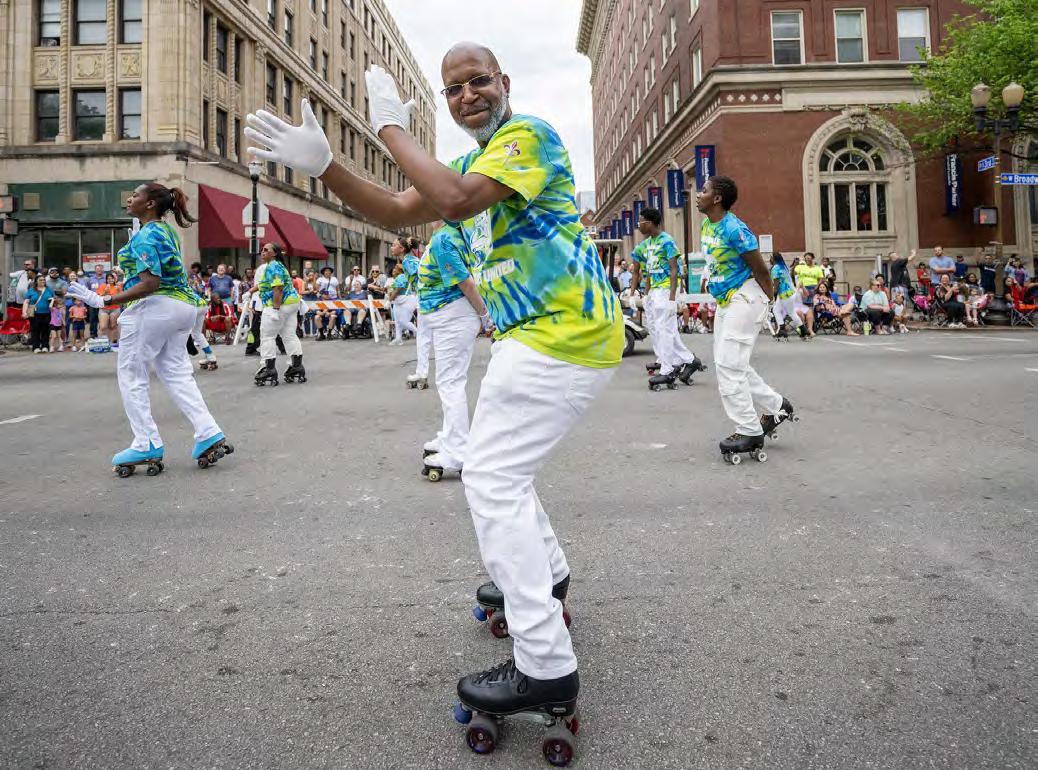
Contributing Sponsors: AFS Foundation & Waterproofing Specialists, Kentucky Kingdom & Hurricane Bay, Kentucky Tourism, Arts & Heritage Cabinet, Shady Rays and UA Local 502. Official Broadcast Partner: WLKY. Media Sponsor: MIX 106.9.
APRIL 26 • 1-5PM Kentucky Derby Festival Ken-Ducky Derby
Kroger’s Fest-a-Ville on the Waterfront
See the launch of more than 40,000 ducks into the Ohio River for a chance to race and compete for prizes. Admission is free with a 2025 Pegasus Pin®. To adopt a duck, visit gotducks.org For more information, go to KDF. org or call 502.719.0072. (Food, drink and pets are not permitted.)
Proceeds benefit Harbor House of
APRIL 27 • 3PM
Zoeller Pump Company Kentucky Derby Festival Pegasus® Parade
West on Broadway from Campbell to 9th streets
Annual parade that kicks off the Derby Week festivities, featuring colorful floats, marching bands, inflatables and equestrians. 2025 theme: Happy Derby: Pink Out Party! (1980s style). Bleacher tickets along route: FREE to the public courtesy of Churchill Downs. VIP Reserved Bleacher tickets in TV Zone: $50 (includes parking pass and complimentary drinks and snacks). Tickets available at KDF. org or call 502.584.FEST.
Sponsor: Zoeller Pump Company.
Contributing Sponsors: Churchill Downs, Kentucky Venues and Waystar. Official Health Care Provider: UofL Health. Official Hotel: The Galt House Hotel. Official Broadcast Partner: WAVE.
APRIL 28
Samtec Kentucky Derby Festival Great Bed Races
6PM Parade of beds 7PM Racing Broadbent Arena
Beds aren’t for sleeping during Derby Week, they’re for racing! Beds on wheels compete in a race around a figure-eight during this annual tradition. 2025 theme: Happy Derby: Pink Out Party! (1980s style). Admission is free with a 2025 Pegasus Pin®. $15 KEC parking. $150 entry fee for a team of vice.
Sponsor: Samtec. Contributing Sponsors:
Venues, Louisville
& Construction, Snap-on and UA Local 502 Apprenticeship Program. Official Health Partner: Baptist Health ER & Urgent Care. Official Finish Line Sponsor: Texas Roadhouse. Official Broadcast Partner: WAVE. Media Sponsor: Classic Rock 107.7.
MAY 1 • 6-7:30PM
Louisville Turners Circus at Kroger’s Fest-a-ville Kroger’s Fest-a-Ville on the Waterfront, Great Lawn
Louisville Turners Circus will perform aerial and ground circus acts, including aerial silks, rope, sling, aerial hoop, and dance trapeze. Admission is free with a 2025 Pegasus Pin®. (Food, drink and pets are not permitted.)


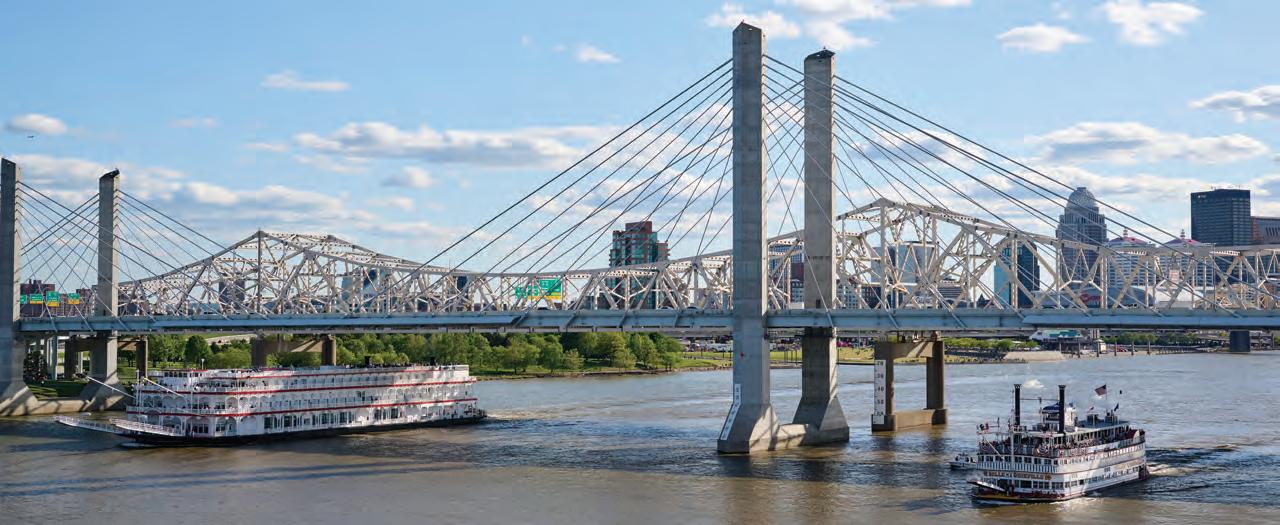


The “oohs” and “ahs” return April 12 for Thunder Over Louisville! The Kentucky Derby Festival opening ceremonies extravaganza includes not only spectacular world-class fireworks but also air shows and drone shows. Enjoy the entire day as a VIP at the Thunder VIP Rooftop Party on top of the Waterside Parking Garage in downtown Louisville.
“The Derby Festival’s Thunder VIP Party offers a front seat to the show in the heart of all the action,” said Matt Gibson, Kentucky Derby Festival president and CEO. “VIP ticket


FAMILY FUN
LOUISVILLE MUHAMMAD ALI INTERNATIONAL AIRPORT
PRESENTED BY KENTUCKY PROUD
holders come to Thunder ready to have a memorable day. We cover the rest with spectacular rooftop views, catered meals and all the amenities.”
Tickets are $225 per person and include prime sky views, a buffet dinner featuring Kentucky Proud cuisine, a complimentary bar, appetizers, VIP tent access and private restrooms.
Tickets can be purchased at ThunderOverLouisville.org.


APRIL 24 - DERBY EVE WATERFRONT PARK, LOUISVILLE, KY
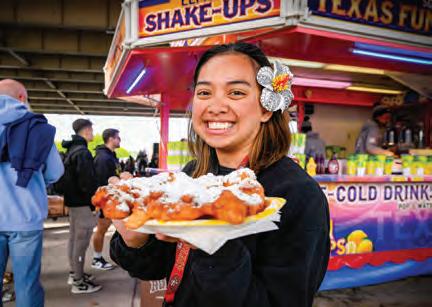



PRESENTED BY FIRST UROLOGY

Running 26.2 miles—or even 13.1 miles—may not be your cup of tea. But 3.1 miles? Now that’s doable. Fortunately, the inaugural Kentucky Derby Festival 5K, Presented by First Urology fits the bill for participants ages 10 and up.
“The Kentucky Derby Festival 5K will offer a unique experience race weekend with an evening run over the Ohio River just before sunset,” said Chris Martini, Kentucky Derby Festival race director. “Festival fans and families at all fitness levels can participate. It’s also an opportunity for runners to get a warm-up in ahead of their half or full [marathon] the next day.”
Those competing in the 5K and the GE Appliances miniMarathon or Marathon will receive a unique Challenge Medal.
The 5K is scheduled for 7 p.m. Friday, April 25. It starts and finishes at Harbor Lawn in Waterfront Park. The course also features a scenic lap on the Big Four Bridge.
To register, visit DerbyFestivalMarathon.com



APRIL 12-27
Kentucky Derby Festival Volleyball Classic Tournament
One of the country’s largest and oldest outdoor volleyball tournaments featuring sand and grass volleyball for all levels of play. For more information, call The Volleyball Connection 502.582.3530 or visit BaxterJacks.com
Contributing Sponsors: ASICS and Mikasa.
Sand Divisions at Baxter Jacks
APRIL 12-13: 9AM-6PM
APRIL 26-27: 9AM-6PM
Grass Divisions at Seneca Park at the Tennis Courts
APRIL 27-28: 9AM-6PM
APRIL 17-29
Stock Yards Bank
Kentucky Derby Festival
$1 Million Hole-in-One Golf ContestSM
April 17-19 and April 21-26:
10AM-8:30PM (Closed April 20 for Easter), April 27: 10AM-5PM, Semi-finals 6PM
Seneca Golf Course Driving Range
$1 per swing. Take a swing at $1 million. Special promotions daily. Grand Prize: $1 million. First Prize (if no Hole-in-One): $5,000. April
18: College Day – College students (with a valid ID) get 2 swings for $1. April 19: Jr. Day –Under 18 get 2 swings for $1. April
21: First Responders and Veterans Day – First Responders and Veterans get 2 swings for $1. April
22: Ladies Day – Ladies get 2 swings for $1. Weekdays: Senior Special 10AM-2PM – Ages 62 and up get 2 swings for $1.
Sponsor: Stock Yards Bank. Contributing Sponsor: Louisville Parks & Recreation. Official Luxury Vehicle: Cadillac/Courtesy Cadillac. Media Sponsor: WLKY.
APRIL 19
PNC Kentucky Derby Festival Tour de LouSM
Metric Century – 8AM, 35-mile ride – 8:15AM, 20-mile ride –
8:30AM. Open course cycling event with three distances for beginners to experienced cyclists. Entry fees and registration info at KDF.org
Sponsor: PNC. Official Health Partner: Baptist Health ER & Urgent Care. Official Nutrition Partner: Kroger. Contributing Sponsors: Scheller’s Fitness & Cycling and West Sixth Brewing. Supporting Sponsors: Louisville Bicycle Club and Louisville Water Company. Media Sponsors: 102.3 The Rose and ALT 105.1.
APRIL 24-25
Kentucky Derby Festival Race Expo And Packet Pickup
Kentucky Exposition Center,
Two-day expo where you can see the latest running gear, get nutritional advice, pre-race running tips and pick up your race packet for the Festival 5K Presented by First Urology and the GE Appliances miniMarathon and Marathon®.
Thursday: 4-8PM Expo and Packet Pickup; Friday: 11AM-8PM Expo and Packet Pickup
Contributing Sponsors: Kentucky Department of Tourism and Kentucky Venues. Official Nutrition Partner: Publix. Media Sponsor: 99.7 DJX.
APRIL 25 • 7 PM
Kentucky Derby Festival 5K, Presented by First Urology
Looped course starts and finishes at Harbor Lawn in Waterfront Park and includes a lap on the Big Four Bridge
New for 2025 Open to participants ages 10 and up. Registration fee: $45. Free for spectators.
DerbyFestivalMarathon.com
APRIL 26 • 7 AM GE Appliances
Kentucky Derby Festival miniMarathon + Marathon®
Kentucky’s largest day of road racing with both 13.1-mile and 26.2-mile routes. Also, Marathon Relay (26.2 miles) for teams of 3-5 runners. Free for spectators. DerbyFestivalMarathon.com
Sponsor: GE Appliances, a Haier Company. Official Medical Provider & Training Partner: Norton Sports Health. Contributing Sponsors: Churchill Downs, Kentucky Department of Tourism, Louisville Water Company, Powerade and


Those who attend the Taste of Derby Festival each year leave satiated with some of the best food and drink Louisville and surrounding areas have to offer. What’s even better is that proceeds from the event provide thousands of free meals to those in need.
This year’s event at Slugger Field in downtown Louisville is April 15 and will feature culinary delights from more than 75 of Kentuckiana’s finest food and drink vendors. The $100 ticket cost goes to Dare to Care, which provides food support to more than 300 nonprofits.
“It’s a ripple impact … and all people have to do is come out and enjoy a fun night of eating lots of food and finding some new restaurants that they want to scout out later,” said Andrea Shepherd, Dare to Care’s senior director of philanthropic partnerships. “For every dollar we raise, that’s two meals that we can provide in the community. We’re seeing food insecurity increase in this community, so it’s potentially as important— if not more important—than ever to really support our neighbors.”
Shepherd said they hope to raise at least $185,000 this year. To purchase tickets and get more information, go to daretocare.org/taste-ofderby-festival.

APRIL 15 • 5:30-8PM
Kentucky Derby Festival “Taste of Derby Festival®”
Louisville Slugger Field
Savor signature dishes from more than 75 of Louisville’s finest restaurants and beverage companies. Tickets: $100 per person. Available in advance only. (21 and over only.) Coordinated by Dare to Care Food Bank and is their largest fundraiser. All proceeds benefit Dare to Care Food Bank and its work to nourish Kentuckiana. For more information, call 502.966.3821 or visit tasteofderbyfestival.org
Presenting Sponsor: BrownForman Corporation.
APRIL 17 • 6:30-9:30PM
Republic Bank
Kentucky Derby Festival BourbonVille®
New Location: Ice House
Taste signature drinks from Kentucky’s Bourbon distilleries, enjoy Bourbon-inspired cuisine and meet the Master Distillers or Brand Ambassadors. Tickets: $75 General Admission; $125 VIP Experience. General admission tickets include bourbon and food tastings, commemorative
glass and BourbonVille event pin. VIP includes complete event experience, VIP area, plus 5:30PM early access, exclusive Bourbon tasting experience and VIP gift. (21 and over only. Must present ID upon entry.) Tickets available at KDF.org, or call 502.584-FEST.
Sponsor: Republic Bank. Contributing Sponsors: Caesars Southern Indiana, Crushed Ice Catering, Danny Wimmer Presents, Four Roses Bourbon, Kentucky Lottery and UA Local 502. Official Luxury Vehicle: Cadillac/Courtesy Cadillac. Official Safe Ride Home Partner: Kentucky Office of Highway Safety. Official After Party Sponsor: Dave & Buster’s. Official H.R. Company: H.R. Affiliates. Supporting Sponsor: Kroger. Media Sponsors: Classic Rock 107.7 and The Voice-Tribune.
APRIL 24-MAY 2
Kentucky Derby Festival Chow Wagon®
Open daily 11AM-11PM, except Sunday NOON-10PM
Kroger’s Fest-a-Ville on the Waterfront
Outdoor food and live music venue. Happy Hour Weekdays 4-6PM $4 beer at the Beer
Garden. Admission is free with a 2025 Pegasus Pin®. (Food, drink and pets are not permitted.)
Sponsor: Kroger. Music Stage Sponsor: Miller Lite.
APRIL 28 • 11AM-1:30PM
Mayor’s Derby Brunch on the River
Riverside, the Farnsley-Moremen Landing
A festive brunch featuring a traditional Kentucky breakfast, music, live auction, and tours of the property including the Moremen Family Chapel. Tickets: $125 per person; $950 for a table of 8. For tickets or information, call 502.935.6809 or visit Riverside-Landing.org
Produced by Riverside, The Farnsley-Moreman Landing.
APRIL 27 • 1-3PM
Louisville Recovery Community Connection 2nd Annual Kentucky
Derby Afternoon Tea
The Seelbach Hilton
Enjoy an English afternoon tea experience, along with traditional tea sandwiches, savory bites and sweets. Guest speakers, door prizes and a fashion contest. Derby attire encouraged. $125 per person. Proceeds benefit Louisville Recovery Community Connection, which provides resources and support for those in addiction recovery. For tickets and more information, visit louisvillerecoveryconnection.org or call 502.398.5258.
APRIL 28 • 5:30PM
Kentucky Derby Festival Knights of Columbus Charity Dinner
5:30PM Social Hour
6:45PM Opening Ceremonies
7PM Dinner
Galt House Archibald Cochran Ballroom
Produced by the Bishop Spalding Council of the Knights of Columbus. For tickets, call 502.893.2220.
APRIL 29 • 6-9PM
Commonwealth Credit Union Kentucky Derby Festival WineFest Mellwood Art Center
Sip and savor more than 100 local wines from Kentucky wineries. Tickets: $30 Designated Driver (available at event only); $75 General Admission; $125 VIP Experience (Limited Availability). General admission tickets include wine tastings, light appetizers, shopping, souvenir glass and WineFest pin. VIP includes 5 PM early entrance, opportunity to barrel taste local wine, VIP gift and access to private room with seating and food stations. (21 and over only. Must present ID upon entry.) Tickets available by calling (502) 584-FEST or online at KDF.org.
Sponsor: Commonwealth Credit Union. Contributing Sponsors: Crushed Ice Catering, Kentucky Proud and Old 502 Winery. Official Luxury Vehicle: Cadillac/Courtesy Cadillac. Official Safe Ride Home Partner: Kentucky Office of Highway Safety. Official After Party Sponsor: Dave & Buster’s. Supporting Sponsor: Kentucky Wineries Association. Media Sponsors: MIX 106.9 and Today’s Woman.
MAY 3 • 10AM-1PM
Historic Homes Foundation Annual Derby Breakfast
Farmington
Dress in your Derby finest for a buffet breakfast on the Pavilion. Proceeds benefit the Historic Homes Foundation. Tickets: $275. For more information, visit historichomes.org/derbybreakfast or call 502.424.4665.



Food trucks, live music, children’s activities and even free health screenings will be at this year’s Block Party at Norton Healthcare Sports & Learning Center in west Louisville. This will be the fourth year for the event, set for Saturday, April 19, from 10 a.m.-8 p.m.
Organizer Latonia Bland said the event gets bigger each year. “Just about everything about the event last year got rave reviews, and I’m talking about every department, not just the amazing food court,” she said. “The entertainment, the MELANnaire Marketplace, the resources, the Kids Zone—everything was wonderful, so it’s been going great.”
Bland said there will be nearly 20 food trucks on hand to satisfy any craving. The MELANnaire Marketplace will feature dozens of vendors highlighting Black entrepreneurs. The Ford Motor Company Music Stage will present musicians, DJs, dancers, visual artists, poets and comedy, and The Kids’ Zone will keep the little ones happy with inflatables and several outdoor activities.
Local nonprofits will also be on hand to help with community needs, including a health and wellness area that will offer free health and hearing screenings.
Admission to the Block Party is free.

APRIL 11 • 11 AM
Kentucky Derby Festival They’re Off!® Luncheon, Presented by BAE Systems
The Galt House Hotel, East Grand Ballroom
Official Kentucky Derby Festival kick-off luncheon. Tickets: $130 each or $1,040 for a table of 8. Tickets available at KDF.org, or call 502.584.FEST.
Presenting Sponsor: BAE Systems. Contributing Sponsors: The Galt House Hotel, Kentucky Department of Tourism and Kentucky Proud. Official Luxury Vehicle: Cadillac/Courtesy Cadillac. VIP Sponsors: Davis Jewelers and Park DuValle Community Health Centers. Supporting Sponsors: Cerity Partners, East and Westbrook Construction and Jeff’s Donuts. Media Sponsor: Louisville Business First.
APRIL 14-15 • 6–11 AM AT&T Kentucky Derby Festival Morning Line
Radio stations from around the region will broadcast their morning shows live from the Kentucky Derby Museum.
Sponsor: AT&T. Contributing Sponsors: Kentucky Department of Tourism and Kentucky Derby Museum. Supporting Sponsor: Visit Owensboro.
APRIL 19 • 10 AM-8 PM
Kentucky Derby Festival Block Party, Presented by Churchill Downs, Humana and Park Community Credit Union
Norton Healthcare Sports and Learning Center
Community celebration of Derbytime traditions featuring local
food, fare and fun. Plus, live entertainment showcasing local talent and family-friendly activities all day! Admission is FREE.
Sponsors: Churchill Downs, Humana and Park Community Credit Union.
Contributing Sponsors: Brown-Forman, Ford Philanthropy, Heuser Hearing Institute, Kentucky Education and Labor Cabinet and ZEON. Supporting Sponsors: BRAINFREEZE: Cones for a Cause, Erica Denise Entertainment, Louisville Parks & Recreation, MELANnaire Marketplace, The Hope Buss and The Hope Village.
APRIL 24-MAY 2
Kroger’s Fest-a-Ville on the WaterfrontSM
Open daily 11AM-11PM except Sunday NOON-10PM
Waterfront Park
ULTIMATE ENTERTAINMENT
EXPERIENCE featuring concerts, family fun, food, kids’ inflatable playground, midway rides. Admission is free with a 2025 Pegasus Pin®. (Food, drink and pets are not permitted.)
Sponsor: Kroger. Music Stage Sponsor: Miller Lite. Pegasus Play-Ville Sponsor: Norton Children’s. Contributing Sponsor: Holiday World & Splashin’ Safari. VIP Trailer Sponsor: Gustavo’s Mexican Grill. Official After Party Sponsor: Dave & Buster’s.
APRIL 25 • 6-7:30 PM Kentucky Derby Festival Ohio Valley Wrestling Run for the Ropes
Kroger’s Fest-a-Ville on the Waterfront, Great Lawn
Special meet-and-greet with OVW stars at 5 PM, followed by
six big matches including a special “Every Man for Himself Free-for-All” over the top rope Battle Royal. Admission is free with a 2025 Pegasus Pin®. For more information, call 833.477.6786. (Food, drink and pets are not permitted.)
Produced by Ohio Valley Wrestling.
APRIL 25 • 8 PM
The Foxies at Kroger’s Fest-a-Ville
Kroger’s Fest-a-Ville on the Waterfront, Chow Wagon Music Stage
Admission is free with a 2025 Pegasus Pin®. (Food, drink and pets are not permitted.)
Sponsor: Kroger.
APRIL 26 • 1-3 PM
Kentucky Derby Festival Saturday Soiree Drag Show
Kroger’s Fest-a-Ville on the Waterfront, Chow
Wagon Music Stage
A Drag Show featuring some of Louisville’s finest entertainers. $350 VIP Experience includes prime seating for a table of 8, plus $80 in food and drink tickets. $35 Individual VIP tickets. General Admission is free with a 2025 Pegasus Pin®. Food and drinks available for purchase. For tickets and information: LouPrideKy.org. Produced by Louisville Pride Foundation (18 and over only. Food, drink and pets are not permitted.)
Produced by Louisville Pride Foundation.
APRIL 26 • 4-8 PM
Kentucky Derby Festival Cars and Coffee
Kroger’s Fest-a-Ville on the Waterfront, Great Lawn
Judging 4:30-6:30PM. Awards
7PM. Enjoy a variety of cars, including muscle, imports and German and American favorites from all over the region under
the lights. The first 50 attendees receive a free T-shirt. Early registration entry fee to display a car: $30 until April 20: Late registration: $35. Register online at KDF.org. Admission is free with a 2025 Pegasus Pin®.
Produced by Cars and Coffee. Official Vehicle Wrap Partner: Digital EFX. Media Sponsor: ALT 105.1.
APRIL 27 • NOON-5 PM
Kentucky Derby Festival Custom Car Showcase at Kroger’s Fest-A-Ville
Kroger’s Fest-a-Ville on the Waterfront, Great Lawn
Enjoy beautifully painted and detailed custom cars from all over the United States and Canada. Admission is free with a 2025 Pegasus Pin®. (Food, drink and pets are not permitted.)
Sponsor: Kroger. Official Vehicle Wrap Partner: Digital EFX.
APRIL 27 • 6:30-9:30 PM
Kentucky Derby Festival GospelfestSM, Presented by Passport Health Plan by Molina Healthcare and Republic Bank
Kroger’s Fest-a-Ville on the Waterfront
Gospel Artist and Choir Showcase featuring Otis Kemp, Tasha Page-Lockhart, Jermaine Dolly and more performances. Admission is free with a 2025 Pegasus Pin®.
Sponsors: Passport Health Plan by Molina Healthcare and Republic Bank. Contributing Sponsor: Park DuValle Community Health Centers. Media Sponsor: B96.5 FM.
APRIL 29
Kentucky Derby Festival Texas Hold’em Tournament
4:30PM boarding and check-in; 6PM tournament begins, plus one-hour cruise (subject to river and weather conditions).






MAY 3
Gates open at 9AM Churchill Downs
For Derby information contact Churchill Downs at 502.636.4400 or visit KentuckyDerby.com.
Belle of Cincinnati, docked at Kroger’s Fest-a-Ville on the Waterfront
$100 Buy-in until April 14; $125 Buy-in after April 14, includes 10,000 in chips and commemorative pin. Add-ons available first hour of play $50 for 5,000 chips. $2,500 first place prize. Payouts for 10% of field. Payouts based on 325 players, payouts pro-rated based on actual number of players. $15 for guests if cruise takes place. LICENSE# ORG0001638. Register by calling 502.584.FEST or online at KDF.org
Supporting Sponsor: Louisville Poker Tour.
APRIL 29 • 5-8 PM
Kentucky Derby Festival Happytail Hour
Kroger’s Fest-a-Ville on the Waterfront, Great Lawn
A pet-friendly (leashes please!) social event. Admission is free with a 2025 Pegasus Pin®. (Food and drink are not permitted.)
Produced by Metro Animal Services.
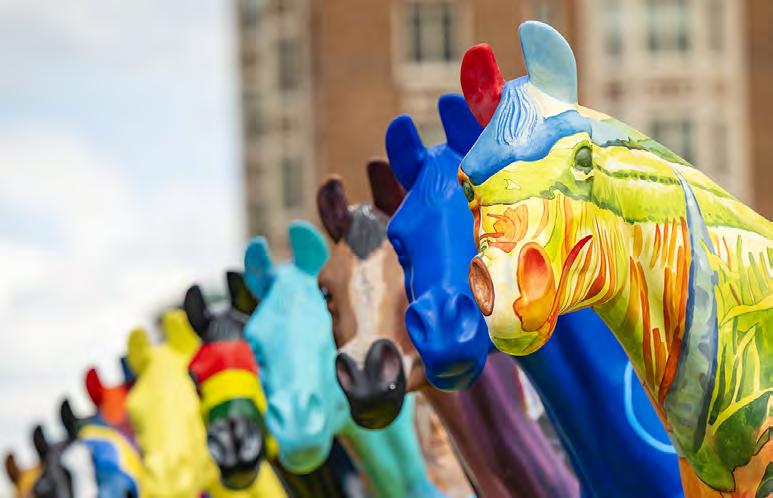
Waterfront, Chow Wagon
Music Stage
Admission is free with a 2025 Pegasus Pin®. (Food, drink and pets are not permitted.)
Sponsor: Kroger. Media Sponsor: MAGIC 101.3.
APRIL 30
Shepherd Insurance
Kentucky Derby Festival
Great Steamboat Race
4:30-5:30PM boarding. 5:45PM departure. Race begins at 6PM
The Belle of Louisville and the Belle of Cincinnati will compete for bragging rights on the Ohio River. Awards presentation immediately following on the Belle of Louisville. Tickets on the Belle of Louisville $200. ForBelle of Louisville tickets, call 502.584. FEST or visit KDF.org. Tickets on the Belle of Cincinnati $85 General Admission, Cruise Only; $130 Dinner and Cruise. For Belle of Cincinnati tickets, call 1.800.261.8586 or visit BBRiverboats.com. Free spectator viewing at Kroger’s Fest-a-Ville and along the banks of the Ohio River.
Tequila: Casamigos Tequila. Supporting Sponsors: Belle of Louisville and Belle of Cincinnati.
Media Sponsor: Q103.1.
APRIL 30 • 6 PM
Kentucky Derby Festival Louisville Urban League Derby Gala
Norton Healthcare Sports and Learning Center
The annual Derby Gala features Grammy-nominated artist Janelle Monáe. Dinner, live concert, auction, programming and dancing. Produced by the Louisville Urban League. All proceeds benefit the Louisville Urban League. For tickets and more information, visit lul.org, or call 502.585.4622.
MAY 1 • 11:30 AM
Kentuckiana Honda Dealers Kentucky Derby Festival Day at the Downs
Churchill Downs, Fourth Floor, Skye Terrace
APRIL 29 • 8 PM
Unlimited Show Band at Kroger’s Fest-a-Ville Kroger’s Fest-a-Ville on the
Sponsor: Shepherd Insurance. Official Patient Care Provider: PPL Therapeutic Services, PLLC. Official Bourbon: Brough Brothers Distillery. Official
Celebrate Thurby at the track with a great view and allinclusive ticket. Tickets: Reserved Seating: $375 each; $3,000 for a table of 8. Preferred Seating: $400 each; $3,200 for a table of 8. Tickets available at KDF.org, or call 502.584.FEST.
Sponsor: Kentuckiana Honda Dealers. Contributing Sponsors: KRC Roofing & Construction and SoIN Tourism. Media Sponsors: MIX 106.9 and The Voice-Tribune.
MAY 1 • 7-9 PM
Kentucky Derby Festival Ohio Valley Wrestling Live Kroger’s Fest-a-Ville on the Waterfront, North Great Lawn Live televised Ohio Valley Wrestling event. Special meetand-greet with OVW stars at 6 PM. Admission is free with a 2025 Pegasus Pin®. For more information, call 833.477.6786. (Food, drink and pets are not permitted.)
Produced by Ohio Valley Wrestling.
MAY 9
Pegasus Pin® Gold Pin Winner Grand Prize Drawing
2025 Gold Winner Pins are eligible to win a new $20,000 cash Grand Prize given away on Friday, May 9. To be eligible, register pins online at PegasusPins.com. Drawings broadcast on WAVE.



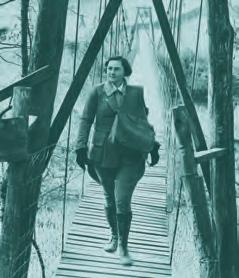








BY TRACEY TEO
Shawnee warriors led by Chief Blackfish have lurked outside Logan’s Fort for weeks, forcing its inhabitants to live under a cloud of fear and anxiety. Venturing outside the Kentucky frontier fort is risky, but food is scarce, so on May 30, 1777, three brave women put on their bonnets and leave to milk cows under the protection of William Hudson, Burr Harrison, John Kennedy and James Craig—all armed with flintlock muskets.
The party immediately is ambushed.
A shrill war cry echoes throughout the forest, and the Shawnees pounce from their lair. Hudson is gunned down, and a warrior in tribal war paint holds his scalp high as a battle trophy. Rapid gunfire is exchanged as the settlers race back toward the fort in terror. The women make it to safety, as does Kennedy, although he’s gravely wounded. Harrison lies injured outside the fort, but Col. Benjamin Logan, the fort’s namesake, shows courage by risking his life to drag Harrison to safety.
It’s just the beginning of a 13-day ordeal.

That’s how the re-enactment of the Logan’s Fort Siege of 1777 plays out annually at a reconstructed fort in Stanford (Lincoln County), a small Central Kentucky town established in 1775. It’s especially noteworthy this year as Stanford (some say the name is derived from “Standing Fort”) commemorates the 250th anniversary of its founding with a roster of history-focused events this spring.
Ken Hill, a history buff from Columbia (Adair County), spearheaded the inaugural Logan’s Fort re-enactment in 2016.
The idea came to him after he led a presentation for school children at the fort several years ago. He was disheartened to learn that only a handful recognized the name Benjamin Logan. He joked that Logan “didn’t have as good a publicist as Daniel Boone,” the widely lauded hero of westward expansion who founded Fort Boonesborough, a settlement 45 miles northeast of Stanford, the same year.
“Logan’s Fort was almost forgotten,” Hill said, “but a lot of critical and key elements of Kentucky history took place within sight of that reconstructed fort. I’ve tried to make Kentucky history real for people.”
This year’s re-enactment takes place on May 17 at the reconstructed fort on 500 Martin Luther King Jr. Street in Stanford.
• • •

Scott and Kristi Heasley of Nicholasville regularly participate in re-enactments at Fort Boonesborough.
Before Kentucky became the 15th state in 1792, it was a wild frontier, a violent and bloody place where only the strong survived. Fortified towns were common, and there were several in Central Kentucky during the colonial era. Their main purpose was to protect settlers who were encroaching on Native American tribal hunting grounds from retaliation.
In an effort to manage relations with American Indian tribes after the French and Indian War (1754-1763), the British crown issued the Royal Proclamation of 1763, which prohibited colonial expansion west of the Appalachian Mountains and reserved the land for indigenous people. It was largely ignored by land-hungry colonists and did nothing to stem the ever-growing tide of settlers.

The reenactment at Logan’s Fort is an opportune time to reflect on a complex founding story and how the collision of two vastly different cultures shaped the modern United States.
As Hill noted, it’s impossible to discuss Kentucky’s early history without bringing Daniel Boone into the conversation. In addition to numerous books about the famed frontiersman, much can be learned at Fort Boonesborough State Park near Richmond. It features a replica of Kentucky’s first fortified settlement, founded by Boone in 1775.
In the spring of that year, Boone and a crew of ax-wielding pioneers cleared a narrow route called Boone Trace through the Cumberland Gap, a break in the Cumberland Mountains at the junction of Kentucky, Tennessee and Virginia. This narrow, hazardous passage was the first road into Kentucky, a gateway from the East Coast colonies into an uncharted wilderness. After the route was widened and improved in the 1790s, Boone Trace became known as the Wilderness Road.
Fort Boonesborough, a settlement on the banks of the Kentucky River, was the end of the line for the axmen’s weeks-long odyssey.
The Boone Trace 250th Commemorative Relay honors these literal trailblazers with a 250-mile hike that kicks off from Kingsport, Tennessee, on April 23. Teams hike 10 miles a day, passing along an ax symbolic of Boone’s axmen to the next team.
The journey culminates in a celebration on June 7, when hikers enter the reconstructed fort and are greeted by Daniel Boone himself—actually, Steven Caudill, a re-enactor who is a descendant of one of Boone’s brothers.
Now open at the Lexington Public Library, “Collected Memory: Items and Artifacts from 250 Years of Lexington History” is a an exciting new history exhibit commemorating 250Lex.
The exhibit includes items from the library’s Kentucky Room collection and loans from the Lexington History Museum, Keeneland, the University of Kentucky and local residents.
This exhibit will be on display through July 13 at the Central Library Gallery (first floor), 140 East Main Street.
Learn more at 250lex.com or lexpublib.org
This working fort with costumed interpreters offers an enlightening glimpse of pioneer life. Sparsely furnished one-room cabins are reminders that meeting the basic human needs of food, shelter, clothing and security was a never-ending task.
A gunsmith crafts firearms similar to those used in the fort’s defense, and women in colonial attire demonstrate weaving and spinning techniques.
The memorabilia cabin illustrates Boone’s abiding impact on the American imagination and mid-century pop culture, much of it inspired by the Daniel Boone TV series that ran from 1964-1970. Boone-inspired coonskin caps marked many a Baby Boomer’s childhood and remain oddly iconic of the explorer despite historians denying he ever wore one. Lunch boxes, books and toys are among the nostalgic collectibles.
• • •
Not every 250th anniversary celebration in Central Kentucky focuses on pioneer struggles. Lexington, known worldwide as the “Horse Capital of the World,” boasts a horse-racing history that can be traced back to the settlement’s founding. The first formal racetrack opened in Lexington in 1789, predating Louisville’s Churchill Downs, built in 1875, by 86 years.
On the outskirts of Kentucky’s second-largest city are dozens of horse farms that awe visitors with their bucolic beauty.
“Meet the Neighbors” (that’s NEIGHbors) on June 14-15 is a free annual event that offers tours of some of the most prestigious horse farms in the Bluegrass Region.

(Outside of this event, tickets can be purchased at visithorsecountry.com.) What better time than the anniversary of the city’s founding to celebrate the evolution of its signature industry—the breeding, racing and selling of Thoroughbreds?
Many horse farms are open for tours, but Runnymede is the granddaddy of them all. The 365-acre Bourbon County farm was founded by Confederate Col. Ezekiel F. Clay in 1867, making it the oldest continuously operated Thoroughbred breeding farm in Kentucky.
In a verdant pasture surrounded by lush rolling hills, mares and their wobbly foals frolic in the warmth of the sun, captivating the equine enthusiasts at the fence. A chestnut filly with a gleaming coat wanders over to greet


them, and a little girl offers a peppermint, holding her hand out flat, as instructed. She giggles as the horse’s warm muzzle tickles her palm and is delighted by the interaction with the majestic creature that is equal parts grace and power.
Brutus J. Clay III, chairman and CEO of Runnymede Farm, is as charmed by the playful foals as his visitors, even though it’s a springtime ritual he’s seen many times on this farm that’s been in his family for generations.
“At such a young age, less than a month old, the foals are all legs—figuring out their balance—but they will show these short bursts of speed, and it’s an incredible thing to witness,” Clay said. “I start dreaming of what they will become, and I invite guests to dream with me.
They might be looking at the next Kentucky Derby or Oaks winner.” It’s happened before.
Mage, the 2023 Kentucky Derby winner, was born and raised on the farm, one in a long line of Runnymede stars.
Another way to familiarize yourself with Kentucky’s long racing tradition is to bring a fat wad of cash to Keeneland, a National Historic Landmark, for the Spring Meet April 4-25. It’s thrilling to choose a favorite and cheer on 1,200 pounds of rippling muscle as it thunders around the track. Even if you’re not a bettor, you’ll feel like a winner rubbing elbows with racing royalty.
No worries if you can’t make it to Keeneland in April—the track provides a variety of tours year-round. The Backstretch Tour is a chance to see athletic Thoroughbreds train on the track and then visit the backside— the barn area—where these equine athletes are stabled and cared for.
Still pumped from the adrenaline rush of their morning workout, some horses stamp restlessly as they are bathed, while others relax and allow grooms to brush their coats to glistening perfection. It’s clear that, like humans, each horse has its own unique personality.
“Of Turf and Stone: Keeneland Through the Ages” is a photography exhibit at the Keeneland Library that chronicles the 90-year-old racetrack’s development from its founding in 1935 through the present. Sepiatoned images curated from the library’s collection depict crowds in the stands on opening day in 1936, the track’s first Thoroughbred tent sale in 1943, and a bugler playing the call to the post in 1950. The exhibit is free and open to the public through mid-August. Q
Find Kentucky Monthly Magazine and much more at any of these local bookstores!
Broadway Books
1537 Winchester Avenue, Ashland broadwaybooksaky.com
606.694.7100
Carmichael’s Bookstore
1295 Bardstown Road, Louisville 1313 Bardstown Road, Louisville 2720 Frankfort Avenue, Louisville carmichaelsbookstore.com
502.456.6950
CoffeeTree Books
159 East Main Street, Morehead coffeetreebooks.com
606.784.9877
From the Ground Up
205 E Main Street, La Grange
160 Frank E Simon Ave, Shepherdsville fromthegroundupbooks.com
502.531.0032
Kenton Stories with Spirit
11 West Second Street, Maysville Kenton.social
606.407.6037
Kentucky Soaps and Such
203 West Main Street, Stanford kentuckysoapsandsuch.com
606.365.0808
Main Street Books
21 North Main Street, Monticello msbmonticello.com
606.753.6125

Plaid Elephant Books
116 North Third Street, Danville plaidelephantbooks.com
859.449.2010
Poor Richard’s Books
233 West Broadway, Frankfort poorrichardsbooksky.indielite.org
502.223.8018
Read Spotted Newt
221 Memorial Drive, Hazard readspottednewt.com
606.373.4811
Roebling Pointe Books & Coffee
306 Greenup Street, Covington
301 Sixth Avenue, Dayton 601 Overton Street, Newport roeblingbooks.com
859.240.9476
Taleless Dog
204A Estill Street, Berea thetalelessdog.com
859.302.8757
The Shire Bookstore
115 Newman Drive, Eddyville shirebookstore.square.site 254.245.0439


BY TOMMY DRUEN
On Sept. 29, 1859, more than a year and a half before the first shots of the Civil War echoed at Fort Sumter, Louisville’s CourierJournal featured an advertisement from Chatfield & Root’s variety store on 4th Street announcing it had “base balls” in stock. That notice marked the first reference that Kentucky officially had caught the baseball fever that was sweeping the nation, signaling the dawn of the sport’s presence in the Bluegrass State. This marked the beginning of Kentucky’s storied relationship with baseball, which has endured for more than a century and a half.
By 1867, the landscape of
Kentucky was dotted with organized community baseball teams. Some of the earliest references to these clubs were in cities such as Louisville, Lexington, Paducah, Frankfort and Georgetown. This burgeoning interest in baseball reflected a nationwide trend that saw the sport rapidly rise in popularity after the Civil War. The baseball diamond became a familiar sight in many Kentucky towns, fostering local rivalries and community pride.
The landscape of the sport changed drastically in 1869, when the Cincinnati Red Stockings fielded the first team of paid professional players, setting a precedent that would define the future of baseball.
This shift underscored the game’s evolution from a pastime to the professional sport we know today.
In December 1875, Louisville found itself at the epicenter of baseball history. The Galt House hosted pivotal meetings that led to the formation of the National League, the first major league in baseball history. This new league initially consisted of eight teams hailing from New York, Chicago, Boston, Philadelphia, St.
Louis, Cincinnati, Louisville, and Hartford, Connecticut, marking the beginning of a new era in the sport. These meetings were crucial in shaping the structure and governance of professional baseball, laying the groundwork for the sport’s future.
The Louisville Grays, owned by Courier-Journal publisher Walter Newman Haldeman, debuted in 1876. Playing at the aptly named Louisville Baseball Park, situated where St. James Court stands today, the Grays finished their inaugural season in fifth place with a 30-36 record. The team roster included 16 players, among them 16-year-old Frank Pearce, who remains the youngest player ever to play his final major league game. The Grays’ games drew enthusiastic crowds, reflecting the community’s growing passion for the sport.

1875 | Club owners meet in Louisville to begin talks that will lead to the formation of the National League of Professional Base Ball Clubs.
1884 | Louisville Eclipse star
Pete Browning asks 17-year-old
John Andrew “Bud” Hillerich to craft a bat for him at his father’s thriving Louisville woodworking shop, and a brand is born.
In 1877, the Grays returned with an even stronger team and led the
league standings by August. However, a devastating nine-game winless streak allowed Boston to overtake them, relegating Louisville to second place. In the aftermath, club vice president Charles E. Chase claimed to have received a telegram with information about some of his players. His ensuing investigation would allege that four players had been throwing games, marking the first gambling scandal in major league history. (In his 2024 book The Louisville Grays and the Myth of Baseball’s First Great Scandal, Louisville attorney Wendell Lloyd Jones concludes that the accepted history about the scandal—that Louisville players threw games to benefit gamblers—is not true.) The scandal ultimately led to the Grays’ demise and cast a dark shadow over the sport’s integrity. The investigation and its fallout were significant in baseball’s early history, underscoring the need for stricter oversight.
1899 | Hall of Fame outfielder
Earle Combs, whose future teammates with the New York Yankees will include Babe Ruth and Lou Gehrig, is born in Pebworth (Madison County).
1920 | New York Yankees pitcher
Carl Mays, born in Liberty (Casey County), hits Cleveland shortstop Ray Chapman, a native of Beaver Dam (Ohio County), in the head with a pitch. Chapman died the next day—the only time in major league history that a player was killed as a result of an on-field injury.
1940 | Hall of Fame shortstop
Harold “Pee Wee” Reese, born in 1918 in Ekron (Meade County), makes his major league debut on April 23 for the Brooklyn Dodgers.
1964 | Southgate (Campbell County) native Jim Bunning pitches a perfect game for the Philadelphia Phillies against the New York Mets. Bunning goes on to compile 224 wins and earn a berth in the Hall of Fame.
1982 | The Louisville Redbirds set a minor-league attendance record with 868,418 fans in their first season after owner A. Ray Smith
For five years, Kentucky was without a professional team until 1882, when the Louisville Eclipse, a reputable semi-pro team, joined the American Association, which is considered to be the second major league. The Eclipse enjoyed winning seasons in their first three years, demonstrating competitive play and drawing strong support. Their games were a source of local pride and excitement, once again solidifying Louisville’s place in baseball history.
In 1885, the team was rebranded as the Louisville Colonels. The Colonels experienced middling success for four seasons before suffering an abysmal 27-111-2 record in 1889. A new ownership group took over the following season and turned things around dramatically, with the team finishing with an impressive

moved the team from Springfield, Illinois. The Redbirds will top that with more than 1 million fans the following season.
2002 | Valley Sports of Pleasure Ridge Park (Jefferson County) wins the Little League World Series, defeating Sendai Higashi of Japan, 1-0, in the championship game.
2006 | Coming out of retirement, Cy Young Award winner Roger Clemens pitches three innings of one-run ball for the Lexington
88-44-4 record and winning the league pennant. In the post-season, they faced the Brooklyn Bridegrooms, the National League champions, in an early version of the World Series. The Colonels would end as co-champions after a closely contested 3-3-1 series. This achievement was a high point for the Colonels and for professional baseball in Kentucky.
After the 1891 season, the American Association folded, and the Colonels, along with three other teams, joined the National League. Following this move, the Colonels never again enjoyed a winning record and often found themselves in last place. Even with three future Hall of Famers on their roster, the 1899 season marked their last, as they finished 28 games out of first place. Team owner Barney Dreyfuss then purchased the
Pittsburgh Pirates and consolidated the two teams at the city farther up the Ohio River. This consolidation would end Kentucky’s status as the home of a major league baseball team. •
While devoid of major league baseball for more than a century, Kentucky has established a rich tradition of minor league baseball. These minor league teams have kept the spirit of baseball alive in the state, providing entertainment and fostering community spirit.
Kentucky teams featured prominently in two early Class D leagues. The Kentucky-IllinoisTennessee League, affectionately known as the KITTY League, was formed in 1903 and featured several teams in the western portion of the state. The Blue Grass League,

Legends in front of an overflow crowd of more than 9,000 at what then was called Applebee’s Park.
2006 | Brandon Webb wins the National League Cy Young Award after going 16-8 with a 3.10 earnedrun average for the Arizona Diamondbacks. Webb, a native of Ashland (Boyd County), will finish second in the NL Cy Young voting the next two seasons before injuries end his career.
2007 | The University of Louisville advances to the College

World Series for the first of five times with a 20-2 rout of Oklahoma State.
2009 | The Bowling Green Hot Rods play their first game in front of a standing-room-only crowd of nearly 7,000 at Bowling Green Ballpark.
2024 | University of Kentucky head coach Nick Mingione is named the National Coach of the Year for the second time after guiding UK to its first appearance in the College World Series.



centered around Central Kentucky, began in 1908. Both leagues faced financial difficulties and intermittently missed seasons through the years, with the Blue Grass League folding in 1924 and the KITTY League in 1955. Future Hall of Famer Casey Stengel (inducted as a manager) and Tony Kubek, a shortstop for the New York Yankees who went on to greater fame as a broadcaster, began their illustrious careers in these leagues.
While minor league teams were sporadic in other parts of Kentucky,
Louisville usually has had a team since the Colonels folded. The city has hosted teams with names like the second iteration of the Colonels, the Redbirds, the RiverBats and, currently, the Bats.
Today, Kentucky boasts four minor league teams. The Louisville Bats are the AAA affiliate of the Cincinnati Reds, playing at Louisville Slugger Field, a ballpark that pays homage to the state’s rich baseball heritage. The Bowling Green Hot Rods are a High-A affiliate of the Tampa Bay Rays. The Lexington Legends, playing


in the Atlantic League, and the Florence Y’alls, members of the Frontier League, are in MLB “partner leagues” but not affiliated with a single major league club.
Kentucky’s baseball story is one of early adoption, exemplary talent, passionate fans and a resilient love for the game that continues to inspire and entertain. From the early days of local teams to the enduring presence of rising stars on minor league clubs, baseball remains an integral part of our Commonwealth’s fabric. Q
Kentucky has been a hotbed of minor league baseball for more than a century. One of the Commonwealth’s four current minor league teams will celebrate a milestone this season when the Lexington Legends launch their 25th season on April 25 at Legends Field.
“The whole season is going to be at the highest level of what we’ve done here in terms of the fan experience,” said Alan Stein, a Lexington businessman and civic leader who founded the team in 2001 and pulled together an ownership team to buy it back when it was in danger of folding.
Commemorative events are scheduled throughout the season, but the highlight will be the reunion weekend June 6-8. Stein said players, managers, coaches, staff and anyone else involved with the team over the past quarter-century have been invited back for the celebration.
Perhaps the most legendary Legend was current Houston Astros second baseman Jose Altuve, the 2017 American League Most Valuable Player, who played for Lexington in 2010. Lexington hosted what Stein called “the greatest rehab assignment in baseball history” when Cy Young Award-winning pitcher Roger Clemens pitched three innings for the Legends on June 6, 2006.
The Legends have won four championships since their inception. They play in the independent Atlantic League, a partner league of Major League Baseball.
“We hope we win every game, but whether we do or don’t, we hope it’s a great experience for the fans,” Stein said.
The Louisville Bats opened their season March 28 against Memphis at Slugger Field, their home on the banks of the Ohio River since 2000. The Bats are the AAA affiliate of the Cincinnati Reds. Current Reds All-Stars Elly De La Cruz and Hunter Greene are among the many players who played in Louisville on their way to the big leagues. The Bats play in the International League, a 20-team circuit that traces its origin to 1884 and boasts Jackie Robinson among its alumni who advanced to the majors.
The Bowling Green Hot Rods enter the 2025 season as the reigning South Atlantic League champions, having captured their fourth title in six seasons last year. The Hot Rods are the High-A affiliate of the Tampa Bay Rays. Two-time Cy Young Award-winning pitcher Blake Snell pitched for Bowling Green on his way to The Show. The Hot Rods have called Bowling Green Ballpark home since 2009.
The Florence Y’alls compete in the Frontier League, another independent MLB partner league. They will play their home opener May 16 against the Washington Wild Things at Thomas More Stadium.
BY TED SLOAN





For further information on the events celebrating the bicentennial of Lafayette’s farewell tour, visit thelafayettetrail.org and lafayette200.org
Considered a son by Gen. George Washington, the Marquis de Lafayette is feted on the 200th anniversary of his farewell tour of America
BY JACK BRAMMER
George Washington, commonly known as the “Father of His Country” for his indispensable role in bringing about American independence in the late 1700s, never had any biological children. But the commander of the Continental Army, who led patriot forces to victory in the American Revolutionary War against the better-armed British empire and became the first president of the United States, called MarieJoseph Paul Yves Roch Gilbert du Motier de La Fayette, Marquis de La Fayette “my favorite son.”
Theirs was an extraordinary friendship.
Early Americans called the Frenchman who played a vital role in rallying their military service in the American Revolution “Lafayette.” They treated him like a national celebrity.
“Lafayette was a great friend to Washington and America. He loved
this country and its values on freedom. The people idolized him because he cared. It is fitting that we never forget him and his contributions,” said Julien P. Icher, the head of one of two major nonprofits in the United States that are taking steps to keep alive the name and contributions of Lafayette. Kentucky is heavily involved with activities planned by both Lafayettebased nonprofits as America heads toward its 250th anniversary on July 4, 2026.
Icher is the founder and president of The Lafayette Trail Inc., a nonprofit organization based in Bethesda, Maryland, with the mission to document, map and mark General Lafayette’s footsteps during his farewell tour of the United States in 1824 and 1825 that included Kentucky.
Since 2019, the nonprofit has placed six historical markers about the tour in six Kentucky communities—one each in Smithland, Shelbyville, Frankfort,
Maysville, Versailles and Georgetown. Three are to be installed May 16 in Lexington. A historical marker has not yet been installed in Louisville, but it is in the works.
Chuck Schwan is executive director of American Friends of Lafayette, a historical society that began in 1932 at Lafayette College in Easton, Pennsylvania, and is headquartered in Gaithersburg, Maryland. Its goal is to foster and promote the traditional friendship with France that began with the American War for Independence and to examine documents and discoveries that might shed more light on Lafayette’s life.
American Friends has been working on rallies in the states Lafayette visited on his final tour of America. Several will be in Kentucky May 10-18, with two days of activities scheduled in Louisville.
Schwan said the two nonprofits
are “quite different, but we both try to keep the name of Lafayette alive. Vive Lafayette!”
Lafayette was born Sept. 6, 1757, into a wealthy land-owning family in south-central France. He followed family tradition and was commissioned into the military at age 13. He was fascinated by the “noble cause” of freedom in the New Word and traveled to the colonies to fight for it.
On Aug. 5, 1777, Gen. George Washington, commander in chief of the Continental Army, came to Philadelphia to brief Congress on military affairs. At dinner that night, Washington and Lafayette met. It was said “the two men bonded almost immediately.”
Washington appreciated the young man’s enthusiasm and his position as a Mason. In turn, Lafayette was in awe of the commanding general.
Lafayette became a member of Washington’s staff. He wanted to command a division, but Washington said that was not possible because of his foreign birth. He said he would hold Lafayette in confidence as “friend and father.”
A few weeks later, Lafayette was wounded fighting for the Continental Army at the Battle of Brandywine in Pennsylvania. He later served with distinction in the Battle of Rhode Island. Lafayette returned to France in the middle of the war to seek more financial support for the American Revolution. He came back to America in 1780 and attained senior positions in the Continental Army.
In 1781, Lafayette commanded troops in Virginia that blocked a British Army led by Lord Cornwallis until American and French forces could get into position for the victory at Yorktown that led to the surrender of the British.
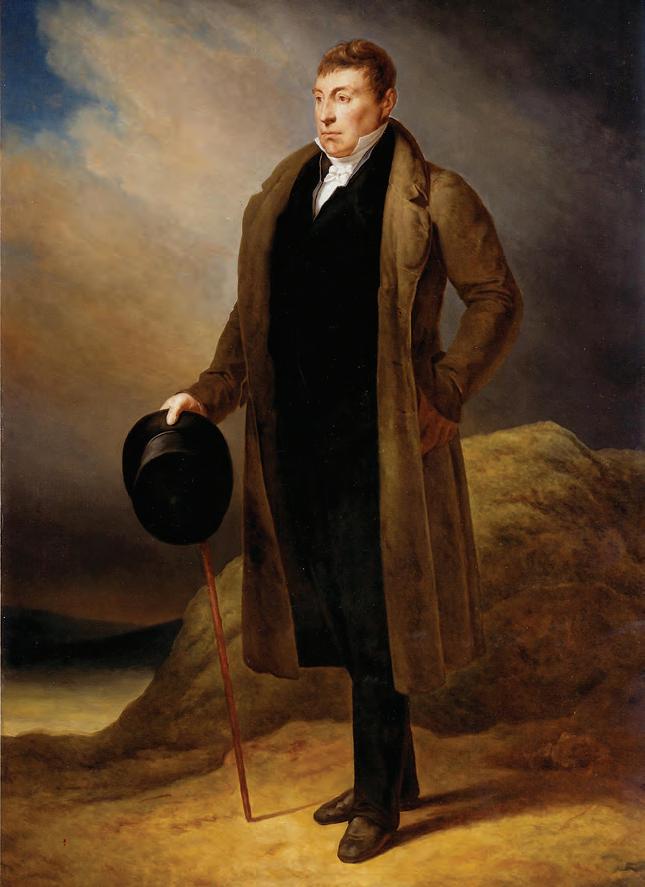
In 1787, Lafayette returned to France and became involved in its government. In August 1792, radical factions ordered his arrest, and he fled to the Austrian Netherlands (comprising present-day Belgium and Luxembourg). Austrian troops captured him, and he spent more than five years in prison.
French leader Napoleon Bonaparte had him released in 1797, but Lafayette refused to participate in Napoleon’s government. In 1814, Lafayette became a liberal member of the French Chamber of Deputies. He held the position for 10 years.
In 1824, U.S. President James
Monroe invited Lafayette to the United States as the nation’s guest of its upcoming 50th anniversary.
Lafayette was the last surviving major general of the American Revolution. He received rapturous receptions wherever he went in the new country and enjoyed reuniting with fellow veterans and the nation’s leaders.
At Monticello in Virginia, Lafayette visited Thomas Jefferson Jefferson’s successor, James Madison, showed up unexpectedly. Lafayette also dined with 89-year-old John Adams, the other living former president, at his home near Boston.
One of the highlights of his trip,

Lafayette said, was his visit to the tomb of his friend George Washington at Mount Vernon in Virginia.
Lafayette went to the tomb alone. He returned to his carriage with tears in his eyes. He later led his son and a secretary into the tomb. They knelt near Washington’s coffin.
In Boston, Lafayette helped lay the cornerstone for the monument at the site of the Battle of Bunker Hill, the first major battle of the American Revolution in 1775. For his return to France, U.S. President John Quincy Adams made available for Lafayette a frigate, the name of which was changed from the Susquehanna to the USS Brandywine
On May 20, 1834, Lafayette died of pneumonia. He was 76. He was buried in a Paris cemetery. He had his son pour atop his grave dirt he had collected from Bunker Hill. He wanted to be buried under French and American soil.
His son’s name was Georges Washington de la Fayette
Kentucky Celebrates Lafayette
The Lafayette Trail Inc. said
founder Icher has entered into an exclusive agreement with the William G. Pomeroy Foundation to place up to 175 official markers in the 24 states on Lafayette’s final tour of America.
Icher plans to be in Kentucky this spring to speak to various historical societies and organizations. For more information about the nonprofit, visit thelafayettetrail.org
The American Friends of Lafayette is coordinating a farewell tour bicentennial on the national level.
Its biggest event in Kentucky will be May 10-12 in Louisville. On the first day—from 10 a.m.-3 p.m. at Old Portland Wharf, 3500 Rudd Avenue—a re-enactment will be held of Lafayette’s arrival. It is free and open to the public.
After the unveiling of a historical road marker, food, snacks and drinks will be provided by the Louisville Thruston Chapter, Kentucky Society, Sons of the American Revolution; the Louisville Committee; and Good Shepherd Catholic Church. A tour will visit the location of the original Portland Wharf nearby.
After the ceremony, the activities


will move to the Portland Museum following the path of the old Portland-Louisville Plank Turnpike to the museum. There will be a speaker and presentation about Lafayette’s trip to Louisville and the local environment in 1825.
An elegant dinner will be served, followed by a dance from 5:30-10 p.m. at the Pendennis Club at 218 West Muhammad Ali Boulevard.
The next day, two benches marking the Lafayette visit and the 250th anniversary of the American Revolution will be unveiled in downtown Louisville at 3 p.m. at 400 West Market Building Park.
On May 12 at 10 a.m., the public may attend a ceremony at 1101 East River Road, the Big Four Waterfront Park, to welcome Lafayette and escort him over the Big Four Bridge. It is about a 40-minute walk.
That evening, from 7-9 p.m., the Kentucky Masons will present a play and host a reception at the Scottish Rite Temple, 200 East Gray Street.
For more details and information about tickets, visit lafayette200.org Q
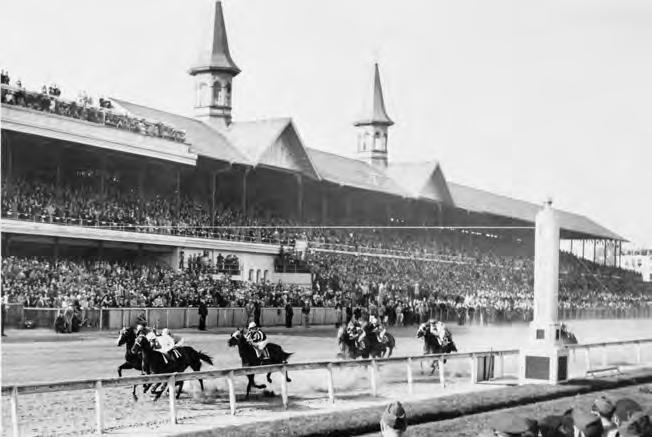
In 1943, Americans faced many travel restrictions due to World War II. Despite calls to cancel the Kentucky Derby, Churchill Downs President Colonel Matt Winn organized what he called a “street-car Derby.” Out-of-state race fans were not allowed to travel to Louisville, and locals had to take the street car rather than drive to the track. An estimated 60,000 turned out for the Derby to see the favorite, Count Fleet, win the race.
Charles Hayes Jr. • Founder
Stephen M. Vest •
Deborah Kohl Kremer • Editor
Rebecca Redding • Typographist
One-Year Subscription to Kentucky Monthly: $25
Letters to the Kentucky Explorer
Letters may be edited for clarification and brevity
John Fox Book Might Be Back in the Family
I have a fun update regarding my story on John Fox Jr. (December 2024-January 2025 issue, page 60). I found a first edition (1895) inscribed copy of A Cumberland Vendetta It is inscribed to Mrs. Bailey. My grandmother was a Bailey before marriage, and her family came from Lee and Wise County, Virginia, which became Fox’s home.
There is a real possibility that the Mrs. Bailey in the inscription is an ancestor of mine. A rare-book dealer had the book for years when I found it, and for its age, the book is in great condition. Fox did not sign many books, and his signature is extremely rare.
John McCauley, Lexington
Revilo is the small community in McCreary County where U.S. 27 crosses into Tennessee. In the 1960s, I remember not much more than a roadside restaurant— maybe an occasional house. Kentucky was “dry,” and Tennessee was “wet.” In the past, there had been a so-called “honky-tonk” built just across the state line. You could buy your liquor in Tennessee and sit down in Kentucky.
One of the old-timers filled us in on how the area came to be Revilo. Around 1800, a survey was commissioned to establish the border between the two states. The chief surveyor was a man named Oliver. As they worked their way through what is now Revilo, the citizens held the surveyor, Oliver, in high regard. But Oliver had a different opinion of the area, and it wasn’t complimentary. He refused to have the area named after him. But the residents had a different idea and did it anyway, spelling Oliver backward—Revilo.
Luther Hargis, Lexington

I have lived on the Ohio River all of my 91 years except for a few years when my husband, also a Hancock Countian, was stationed at Otis Air Force Base on Cape Cod, Maryland.

My mother was raised on a farm in Waitman. My father was from Hawesville, and their first home was on Water Street. It seemed that each year, the Ohio River flooded their home, and it was left covered in mud. My mother said cleaning out the house after a flood was some of the hardest work she ever had to do. In 1933, my parents were able to move to higher ground, and life became a little easier for the family.
In January 1945, my dad—at 37—got his letter from the draft board. He passed his physical and was to leave in March for service at Fort Lewis in Washington state, a long way from Hawesville. In 1945, the Ohio River flooded at a higher point than any year since 1937. The water covered the railroad tracks, and the trains could not run. Did my mother pray for more rain? That would have been unlike her, as she was a compassionate person. However, when Dad left on the train he was leaving her behind with four children and their elderly parents to care for. Also, she could not drive and would still have to tend to the home, garden and farm animals.
Eventually, the waters receded, and Dad made it to Fort Lewis. The war ended in August while he was still in basic training. During this time, the military ruled that all men over 38 would be discharged, so with two months to go until his birthday, he did not have to go overseas as planned.
In the early 1950s, a flood wall was built in Hawesville that still protects the city from devastating floods.
Patsy R. Young, Hawesville
“Until you go to Kentucky and with your own eyes behold the Derby
By David Wheeler, Mount Dora, Florida
Tug Valley runs between the Eastern Kentucky hills along Ky. 32 for more than 30 miles and passes Skaggs, Martha and Blaine in Lawrence County.
During the 1920s and decades before, when the October harvest was over and the cornstalks cut, some Tug Valley farmers took turns allowing the use of their land to show off their horses.
Their horse-drawn discs and harrows got rid of plowed ruts. Then, steel-coated rollers flattened the fields to be used and carefully packed one area into a quarter-mile sprint racetrack.
First came pickup trucks and horse-drawn wagons. Hundreds of tents were pitched and followed by booths that sold beautiful hand-sewn quilts and delicious barbecue.
Privies were dug, and the lines were long.
For a dime, customers could be sprayed from a barrel above them in a canvas wall shower. The water was so cold that only those with muck-covered-emergencies used it.
God was asked to forbid it to rain because hundreds of people were dancing, prancing and entertaining each other. Country singers twanged in front of area bands perched on wooden stands, and guitar players strummed in wagon beds. Gospel songs thundered from the congregation in an evangelist’s tent.
Eloise Cooksey Layman, Mankato, Minnesota
In the 1940s and ’50s, Springfield and Harrodsburg had sewing factories. In Springfield, they made jeans, and in Harrodsburg, they made beautiful wool coats. Many high school graduates could get jobs in these factories. They paid well and taught many skills. Eventually, all these factories closed, and the jobs went overseas.
Speaking of sewing, in the 1950s, girls wore only dresses or skirts with tops to school. Women wore house dresses for every day and beautiful dresses or suits for dress up. Many of us sewed a lot of our own clothing. Sewing was taught in home economics classes by parents and in 4-H clubs. One could be creative when sewing and have an individually designed garment. There was a sense of accomplishment in their work, and it was economical. That changed when foreign countries could make and sell the same clothing for less money. Goodbye to the incentive to sew. Fabric stores advertised craft supplies instead of clothing fabrics.
Here is another reason that sewing clothes is a lost skill: Pants and jeans became an important part of every wardrobe. A typical woman’s closet in the 1940s and ’50s was stocked with dresses, skirts, blouses and sweaters.
Farmers always seemed to have their moonshine-filled Mason jars in hand. Wives stirred cast-iron pots or skilletfried breakfast, lunch and dinner on wood fires. Daughters smiled and flirted, but most boys were ducking and dodging in horse-biscuit fights.
When the horses began to paw and neigh, crowds gathered along the rope-lined hard-packed dirt track. The noise was overwhelming. Most bets were made for work on somebody else’s farm. No one had much money.
After a flapping wave from the wobbly flag tower, the starter fired his gun. Winners were adorned with wreaths of bright autumn leaves and red laurel. Kentucky is Kentucky.
The Kentucky standard of running for roses could not be met for this event, so “wreaths of bright autumn leaves and red laurel” were awarded. It was October. Without greenhouses and refrigeration, roses were unavailable.
Dr. John M. Wheeler, a veterinarian, lived several miles from one of the Tug Valley people-gathering and horseracing sites. Accompanied by his son, Kermit—his assistant—Doc Wheeler treated the horses without charge. Kermit, my father, became one of the few Duke University graduates of that time from the Appalachians and a United Methodist minister, described the location’s appearance and told me about the events.
That closet today would have lots of pants, jeans, T-shirts and sweaters—maybe one or two dresses or skirts. Sewing is still a great skill to have, as many ready-made clothing items need alterations, since few of us are perfect sizes.


Send memories to Deborah Kohl Kremer at deb@kentuckymonthly.com or mail to Kentucky
Frankfort, KY 40602.
Send your memory in today! By
P.K. Compton, Lexington
There is an old saying that when a boy catches his first fish, he’s the one who really gets hooked. I can testify that there is no exaggeration behind the truth of that statement.
In the summer of 1959, at the age of 8, I was spending a week visiting my cousins, Greg and Larry, who lived in Virgie (Pike County). They were the sons of my dad’s younger brother, JD Compton. We grew up together like brothers, and If I hadn’t had those boys for cousins, I’m not sure where I would have found my fun. We hiked, biked, camped, built stuff, knocked down stuff, caught critters and generally stomped around the terrain to the point that my mom and aunt would end up praying for the strength to go on.
I was amazed watching JD take out his pocketknife, cut a few branches, and rig up three fishing poles right on the spot. We brought thread, hooks and bologna bait with us. In no time, we were ready to fish.
Greg ran over the routine with me again, just to make sure that when I felt any tug on the pole, it was the sign to pull up on the line. I had no idea what it felt like to have a fish on the line but was about to find out. We were fishing without bobbers, so we held the poles in our hands, and it wasn’t long before I felt something odd. It kind of felt like an invisible force was trying to coax the pole away from me. Could I have hooked a fish?
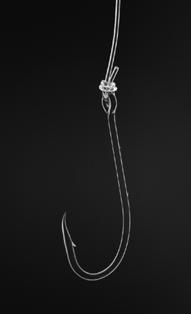
Even though they lived just down the road in Virgie, it wasn’t a short trip from our home in Pikeville in the late 1950s. The long, winding mountain roads demanded at least an hour of your time, and—more often than no—my older sister and her “pink stomach” caused us to stop at least twice.
Dad had talked about taking me fishing, but we hadn’t had the chance to go yet, and as it turned out, JD was the first one to take me. One day, as they drove me home to Coal Run, it was decided that we would stop on the way and fish for a while. Greg and Larry had spent a lot of time over the previous couple of days filling me in on the details of how to fish, but the part that sounded the most exciting was how you could actually end up catching a fish. We stopped just above the Robinson Creek area at a small crystal-clear stream that was probably no more than 15 feet wide, but it looked like a raging river to me. My excitement grew as we jumped out of the car, although I tried to stay calm in front of everybody and not appear too apprehensive. This was a place, I thought, that must be teeming with fish just waiting to get caught. It seemed perfect too, with fresh clean air, a slight breeze, and the sun shining bright on my old Kentucky creek bank. That’s when I first felt the allure of a sparkling stream. It was a feeling that I could never shake.
My uncle was standing close by, and when I drew back on the pole, I caught sight of a fish being pulled toward me in the clear water. At that point, I got so excited that I yanked back with a force that sent the pole, line and fish all in a rainbow arc completely over my head. My uncle turned around just in time to see the fish land behind me, flipping around on the sandy creek bank. I can still remember him chuckling to himself when he saw how excited I was.
Greg was quick to tell me, “It’s a red eye. You caught a red eye!” Greg seemed to always know fish. I looked closer at it, and sure enough, it had blood red eyes. I’m sure that it wasn’t more than 5 inches long, but I felt as though I had just reeled in a marlin. I found out later in life that it was also known by a host of other names including rock bass, rock sunfish, rock perch, redeye bass and google eye. But that was it for me. I was hooked for good. I actually caught a real fish, and it was mine. I don’t remember if any other fish were caught that day, but it was the start of a lot of fishing together for me and my cousins. I couldn’t wait to get home and show Mom and Dad what I caught.
From that point, Dad and I started making trips down to the banks of the Levisa Fork River, which was within walking distance of our house. After a lifetime of fishing, I have never caught another red eye. And looking back on that bright summer day long ago, I came to realize that when you take children fishing, they not only enjoy the thrill of the catch but also develop a lifelong connection with family and environment.
By Peggy Patterson Mull, Louisville
As far back as my memory goes, my mother did her best to take care of us. This involved cooking, cleaning, washing, ironing, helping with a garden and canning food. In the 1940s, our mother did wash in a big galvanized aluminum washtub, in which water was heated over a fire in the yard. The tub was placed on three stacks of rocks, with sticks of wood placed under it. A fire was lit, and the tub was filled with water from the dug well next to the house.
The well had a winch system—a single long pole held several feet in the air between two upright poles. The single pole had a weight on the bottom end that kept a rope held above the well, and when water was to be drawn, a gallon bucket was attached to the rope and then lowered into the water. The weight on the other end of the pole helped with hauling the bucket of water upward. Then, the water was carried and poured into the washtub for heating. When the water was hot enough to suit Mother, lye soap was used to scrub the clothes on the washboard. When I was 7 or 8, I remember learning to scrub clothes on the metal washboard. That was hard to do, but even harder was wringing them out—twisting heavy denim work pants for my father was no easy job for a small girl.

mother. No wash was complete without it. I never knew what it was supposed to do, but it had to be done. Then, she made starch for shirts to be dipped in after wringing the water from them. After that, the clothes could be hung from a clothesline suspended between two upright poles in the yard. Wooden one-piece clothes pins were used. They also made great toys, but we had to be careful not to break them because in our poor household, they were expensive to replace. I could never hang the clothes because the line was too high, but I helped by handing wet items to our mother. She ironed everything with an iron heated on top of the wood-burning stove. I remember seeing her test the bottom to see if it was hot enough. She licked a finger, touched it to the iron, and if it sizzled, it was hot enough. As far as I know, she never burned holes in anything. Winter was the hardest time for wash day. It seemed to take longer for the water to heat, and when it was really cold, the clothes froze as soon as they were pinned on the clothesline. If the outside temperature did not get high enough for the clothes to thaw and dry on the line in a day or so, they were brought inside where they thawed, dripping on the floor, and finally dried as they hung over chairs.
My mother made “bluing” from a recipe from her
By Carol Ingle, Scott County
When I was growing up in Wayne County in the 1950s, my granny took spring cleaning seriously. The potbelly stove was taken down and put in the shed. A colorful tin plate was put up over the hole the stove pipe fit in. The stove was scrubbed with a wire brush, and a black polish went on that stove. The metal mat that the stove sat on was scrubbed.
All the beds were carried outside. The springs were swept and washed. My tiny hands could get inside the springs and get them Granny approved. The feather beds hung on clotheslines, and we beat them until we did not see dust coming out. If someone gave Granny some thick sheets, they were made into new covers. We got to empty the feathers into their new home.
Each room was cleaned from top to bottom. Then, Granny painted all the baseboards and doorways.
If a family member gave Granny their leftover wallpaper,
The wooden ironing board had some kind of homemade padding—old sheets I think. I learned to iron, too, and I still hate ironing and wash day.
she always found a way to use it. If a room had wallpaper on the walls, we had to get the walls wet and then pull the old paper off. After the walls dried, we mixed up flour and water and made a paste to spread on the paper to hang it up. I hated flowers on the paper because we had to line up the flowers perfectly.
My granny was so good at getting stuff. If we were visiting a family member who was remodeling, she asked, “What are you going to do with that linoleum rug you’re taking up? Can I have it?”
The linoleum came to the house and was used on our floors. If it had rough areas, she cut them out and made it work. She revarnished furniture. If something needed painting, it got painted. She rearranged all the furniture when it was brought back in.
Then, all winter clothes were folded up, and mothballs were added to the boxes and in the closets, too.
My granny was the cleanest woman I’ve ever known. I never saw a cockroach until I moved to the city. She even washed our curtains the first of the month.
By David R. Caudill , Daytona Beach, Florida
If necessity is the mother of invention, then need is the father of vision. And if properly nur tured and nourished, it will grow to fulfill that need and fill it abundantly. If Dr. Harvey S. Murdoch could see Buckhorn today, he would be satisfied that his vision continues to grow, and Kentuckians continue to benefit from it.
Need is probably what led a young man into the remote mountains of northwestern Perry County to a little village called Buckhorn. Situated in a valley watered by spills from the mountains and Squabble Creek, Buckhorn today is reached via Kentucky 28. In the early 1900s, it was reached by boat on the nearby Middle Fork of the Kentucky River, by horseback and mule, or by a rough wagon road using fords to cross creeks, and at times even using the creeks. It was an isolated place.
the rendered fat, but many cleaned the intestines, boiled those, and added lye to produce lye soap.

Few, if any, today know what led a young man from Brooklyn, New York, into this remote area, but come he did, and he saw a section of the county woefully lacking in educational opportunities. Few children attended school, and most of those did not finish eighth grade. Their presence was needed at home to help the family survive.
A subsistence economy operated there, as in many other areas of the mountains. It was especially hard there because of the isolation. Families raised vegetables and fruits, which they either canned or dried. Root crops were buried in holes in the ground. They had a cow, if they were lucky, some chickens, and a few hogs—these ran wild in the forest. Each family had a mark that they cut into the hog’s ear to identify it, and when cold weather set in, they hunted , killed and butchered it.
Hogs were important to the mountain folk. Whereas cows could supply milk, butter and beef, they provided only one calf per year, while hogs had at least two litters of pigs each year. The pork could be salted or smoked, and if the weather was cold enough, just hung in the smokehouse for short periods of time and eaten fresh. The hogs also produced lard. The fat was rendered, thus supplying cooking lard. Another use of the hogs was soap. Some used
Mountaineers also hunted and fished. Raccoons, rabbits, squirrels and groundhogs found their way into the family pot. Their hides were prepared for sale, along with those of skunks and foxes The money was used to buy powder and lead for shot, plus salt, sugar and coffee. Families fished in the nearby creeks and rivers and augmented their meals with frogs and turtles. All of the above provided the food. But there also was cooking, cleaning, washing and storing the food for the winter. There was wood to cut, fences to make by splitting chestnut, wood shakes to prepare for mending roofs, and many other chores to keep the children busy. It is no wonder that few attended school, and those who did were not able to attend regularly. The family just could not spare them.
This is what Murdoch found when he visited the area. What he envisioned was a school nestled between the hills that would raise the level of education among the citizens and, at the same time, raise their standard of living.
There was no high school in the area. The county had a sprinkling of schools that they called “ junior high schools” because they taught only through ninth grade, but most taught eight grades. Those who wished more than an eighth-grade education had to leave Buckhorn and live in Combs or Hazard. Few could afford that. Murdoch realized that even at Buckhorn, he would have to provide rooms and meals for area students who lived any distance from the school.
Founded in 1902, Witherspoon College was not what we think of as a college today. Rather, it was what we consider a high school. In the early years of American history, many high schools were called “colleges” or “academies.” Their purpose was to prepare students for further studies in medicine, law, ministry or teaching.
Witherspoon’s curriculum included math, English and American literature, Latin, Bible study, and world or European history. Home economics and some shop classes were added later. School lasted six months.
Teaching requirements in 1902 were low. High school graduates taught school. In a letter to the editor of the Berea News printed on June 7, 1907, Elmer Gabbard, who one day would be a leader of the Buckhorn community, wrote that Witherspoon College had just finished a six-week term for prospective teachers. The curriculum included subjects such as teaching methods, drills and practice.
Witherspoon started small, but it had 200 students by 1907. There was a church, school, library and dormitories. Room and board cost $1 per week, and if a student could not afford that, he or she could work it off. That meant working some during the week, on Saturdays, and if your job required it, on Sundays.
There was plenty of work. The buildings had to be cleaned, fires had to be built and maintained, and there was farm work to do. There was food preparation for the students, crops to be put in and harvested, plus cows and other animals to care for. A typical work detail for a girl might be preparing meals, washing dishes or helping with the washing and ironing.
One such person was Wanda Mae McIntosh, class of 1935. She lived in Yerkes, about 15 miles from Buckhorn. She attended an elementary school through eighth grade, then attended ninth grade at at Solar School in the community of Busy. Her choice, if she wanted to go to high school, was to catch a train each day, attend school in Combs, and return home. An alternative was to catch the down train to Chavies, then hire a taxi to take her over the hill to Buckhorn. She had many brothers and sisters, so her family couldn’t afford it. Instead, she and her older sister Irene, class of 1933, attended Witherspoon. Room and board by then had risen to $10 per month or about $2.50 per week. Her father paid $5 per month for each of his daughters, and they both worked off the remainder.
Wanda cooked breakfast each day, attended school from 8 to noon, washed dinner dishes, went to the library for an hour to study, then worked another 1 ½ hours helping prepare supper. On Saturdays, all girls pitched in to do the wash. Wanda was allowed to go home for Christmas and another holiday in the spring.
A boy might be assigned as a field hand, where he plowed, sowed, hoed and harvested the crops. He then had to clean barns, spread manure and mend fences. He did this after school and on Saturdays.
One such boy was Marshall Colwell, class of 1934. He was from Forked Mouth Creek near Yerkes. He also had to go by train to Combs High School, and his father couldn’t afford the $5 per month, so Marshall had to work off his entire room and board. He
was assigned the milk detail. He milked cows in the mornings and evenings seven days a week.
Wanda, Irene and Marshall are prime examples of what Murdoch sought. All three attended Caney College, now known as Alice Lloyd College in Pippa Passes, where they earned associate’s degrees. This allowed them to begin teaching. They spent their summers at Eastern Kentucky State Teacher’s College (now EKU) at Richmond, where all three earned bachelor’s degrees in education. Wanda went on to earn her master’s degree in elementary education there. Marshall earned his master’s degree in education with a field in principalship at Peabody College in Nashville. Kentucky students gained from their education, as Wanda and Irene taught for many years in rural areas, most in one- or two-room schoolhouses. Marshall returned to Buckhorn as principal in 1955 and remained there for four years.
Witherspoon (soon to be called Buckhorn) wasn’t a self-sustaining entity. Rather, it was a mission for Presbyterian charities. Without the synod’s support, the mission would have failed. There were some tough times, especially during the Great Depression. Wanda McIntosh recalls they had to eat soybeans, and one can believe it. When economic times are hard, mission-giving falls.
Because religion played such an important role, students were required to attend church on Wednesdays and Sundays, and many students sang in the choir. Sunday afternoon was a quiet time. All students had to be in their rooms so that they might reflect on the message preached that day. The students remained in their rooms and were subdued, but one wonders how much reflection is done when it is a requirement.
If you compared the village of Buckhorn today with what it was a century ago, you wouldn’t see much difference. The buildings are larger and newer, and the roads are blacktopped, but it hasn’t grown much in size. But Witherspoon or Buckhorn school has changed. Aside from the high school, there is now an elementary school. There also is a home for small boys and girls. This was added for orphans and for children placed by the courts because of neglect or abuse.
Yes, need is the father of vision, and if properly nurtured and nourished, it will grow to fulfill that need and fill it abundantly. If Murdoch could see Buckhorn today he would be satisfied that his vision continues to grow and Kentuckians continue to benefit from his vision.
Between 1903-1957, more than 6,000 mountain children attended Witherspoon College High School, and 1,500 graduated. In 1957, operation of the school transferred to the Perry County Board of Education. Students in Perry County continue to attend the Buckhorn School, now a K-12 public institution (buckhorn.org)
Author David R. Caudill was a member of the Witherspoon class of 1956. He was a field hand while attending the school.
By Jeanne Greiser, Alexandria and Evelyn Dietz, Alexandria
St. Paul’s United Church of Christ of Alexandria celebrates 175 years of continuous service to the community in Campbell County this year.
In 1850, 15 German families established a German Protestant church—the Evangelical Church Congregation of Alexandria. They met in a small log cabin, and services were in German. In 1900, they placed the cornerstone for
the current church building at 1 North Jefferson Street. The building was completed on Feb. 16, 1901. The Cincinnati Enquirer covered the church’s dedication in an article printed on June 23, 1901. The article announced the upcoming event: “The new German Protestant St. Paul’s Church at Alexandria will be dedicated with appropriate ceremonies today. Many pastors from adjoining parishes will be present.”
Throughout the decades, 1850-1923, the congregation grew and changed. There were marriages, baptisms, confirmations, funerals and struggles. Some members of St. Paul’s went to war, and some came home. The office or council secretary probably recorded these facts in German in a ledger, changing to English in the early 1900s.

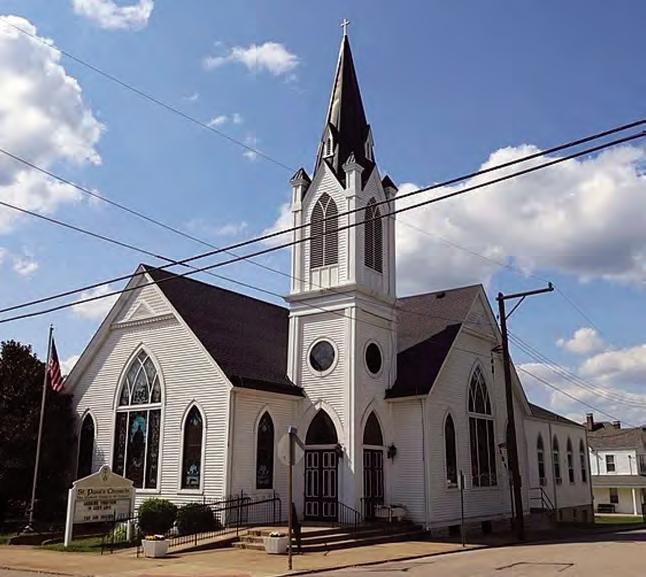
Unfortunately, all records from 1850 through 1923 were lost in a fire. The facts surrounding the fire are vague. One account is that in order to prevent the minister from entering the church, someone put a chain and a padlock on the church sanctuary doors. In retaliation, the minister threw the records into the street and set them on fire. The other story is that someone in the office was cold and used the paper records to build up the fire in the heating stove.
Regarding the story about the minister and the padlock, some members of the church council filed a civil suit in court that included five charges against the minister. The charges involved the collection of funds to pay for church souvenirs and pamphlets, printing tickets for a church show, and profane language. The minister retaliated by filing three suits against the individuals—two were for defamation of character and a third to recover his salary. There were daily and weekly accounts in the newspapers. Subsequent restraining orders prevented
the minister from holding church services and funerals. Some Sundays, the minister ignored the order and held services anyway. Then those in opposition would conduct a follow-up service without the minister.
One Sunday, the trustees barred the doors so the minister held services on the lawn of the parsonage. Another Sunday, the minister held church services in a field on a supporter’s farm.
During the court sessions, there were loud voices on both sides finding fault with each other, physical confrontations and countersuits. The courts were involved from the spring of 1922 until the fall of 1923. Eventually,
the minister decided it was time to leave, and he and his family moved to St. Louis.
Unfortunately, any written milestones that were part of the church between 1850-1923 no longer exist.
All historical information used in this article was part of St. Paul’s anniversary booklets; a recording of minutes by the Lydia Verdin Women’s Group of St. Paul’s; local newspapers, including The Cincinnati Enquirer, The Kentucky Post, Kentucky TimesStar, Courier-Journal and The Lexington Herald; family records and memories; Kentucky court c1ase records; and public records, including marriage and land deeds.
By Owen Rouse, Santa Fe, New Mexico
In 1946, Jerry Lederer opened a roast beef sandwich stand on South Limestone Street in Lexington. He reportedly had planned to name it “Jerry’s Five-and Dime,” but the business soon switched its focus to the more popular—and more affordable—hamburgers, and it became known simply as “Jerry’s.” By 1948, Jerry Lederer was joined by business partner Warren Rosenthal, and in the 1950s, the two began opening franchise locations in other towns. By the early 1960s, they had begun opening drive-in restaurants in Lexington, Frankfort (now Big Daddy’s Fried Chicken) and other cities. By the middle of that decade, there were more than 50 locations in six states.
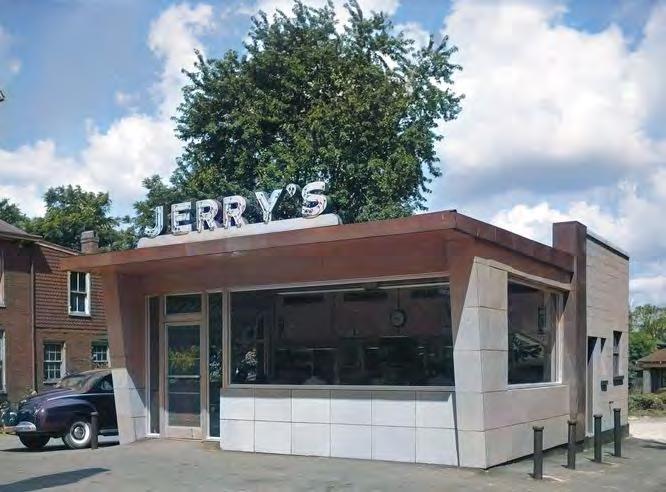
Jerry’s drive-in restaurants were popular during the years when growing families and newly licensed Baby Boomers also made drive-in movies popular. In the 1980s, Jerry’s restaurants and drive-ins began to fall out of favor. By 1990, most of them had been sold to Denny’s, and only a few scattered restaurant locations were still known as “Jerry’s.” By 2021, only one remained open, and it is in Paris.


By Harold Brown, Indianapolis, Indiana
Natural resources, topography, climate, natural processes and human activity over time determined the area now called Kentucky. Coal and limestone were formed long ago and have had much impact even into current times. Hardwood forests and other plants covered and protected the land from erosion and provided the basic needs of many animals. There were prehistoric animals.
The topography of Kentucky varies greatly. It includes mountains, knobs, the Bluegrass and prairies. The rivers and lakes are plentiful. The Cumberland River starts in Harlan County, flows through Cumberland Lake and over Cumberland Falls, goes to Nashville, and comes back into Kentucky, bounding the Land Between the Lakes before entering the Ohio River. It is 787 miles long, draining more than 18,000 square miles.
The Appalachian Mountains were a barrier to settlers already in the states or territories of Virginia and North Carolina. Cumberland Gap and Pound Gap were important to the settlement of Kentucky. The Ohio River was another entry route.

environmentalists became involved regarding coal, timber and other natural resources. Seeking freedom, independence and other needs for their families, many were willing to take risks, such as working far underground in dangerous conditions. Some risked much in moonshine endeavors. Isolated areas had limited access to education, law enforcement, medical care, transportation, communication and employment. Feuds were common in some communities. Subsistence living was common. Lack of education and marketable skills locked many in terrible circumstances. Share cropping and subsistence farmers were typical. Trading and bartering were attempts to improve conditions. Most of the large families’ children had to migrate to areas where their economic and other needs could be more attainable.
Native Americans had informal but enforced agreements to use the Kentucky territory for hunting only. Their hunting grounds and overall way of life were at risk from the settlers from Europe and elsewhere. Resistance was strong. New settlers seeking freedom and better lives for their families, along with governmental authorities, caused many “trails of tears” and worse. The hunters’ paradise became a “dark and bloody ground” for immigrants and Natives.
Limestone was formed from the shells of animals that had lived in the seas long ago. This limestone and fertile soil enabled much vegetation to grow well to benefit the animals, such as bison, elk and eventually cattle and horses. Mammoth Cave, agriculture, Kentucky bourbon, the racehorse industry, the Kentucky Derby and much more resulted. Burley tobacco was the backbone of the economy of many families and businesses for decades.
Coal motivated many to mine it. Workers, entrepreneurs, bankers, lawyers, unions and
The Civil War was disastrous for Kentucky and elsewhere. As a border state, Kentucky and its people were involved and at risk. Loyalties varied greatly. In 1860, 25 percent of Kentuckians were enslaved. Kentucky was the birthplace of both Civil War presidents—Abraham Lincoln and Jefferson Davis Lincoln was quoted as saying, “I hope God in on our side, but I must have Kentucky.” Reconstruction was problematic, due in part to Lincoln’s assassination. As always, there were winners and losers, but it seems that there are no real winners of civil wars.
Our ancestors depleted the bison and displaced the Natives while trying to make better lives for themselves and their families. European diseases killed many Native Americans. Aggressive governmental policies and attitudes of exploration and exploitation were major accelerators of these changes. The risks and benefits of the free enterprise system were evident in enhancing economies but also in reducing many natural resources and damaging much. Numerous generations have experienced the beauty and enjoyment of living in and being from Kentucky.
Sweeping generalizations can allow inaccuracies, but I think my conclusions over time and from many sources are basically correct.
Waveland Tea Tuesday – every Tuesday at Waveland Historic Site in Lexington. For more information, call 859.272.3611.
A Life in Color: An Exhibit by Caryl Bryer Fallert-Gentry at the National Quilt Museum in Paducah, March 14-Oct. 7. For more information, call 270.442.8856 or visit quiltmuseum.org
Battle Frankfort: A Civil War “Staff Ride” of Kentucky’s Capitol at the Thomas D. Clark Center for Kentucky History in Frankfort, April 5. For more information, call 502.564.1792 or visit history.ky.gov/events
SCKCC Welcomes Home Vietnam Veterans at South Central Kentucky Cultural Center in Glasgow. Exhibit throughout 2025. For more information, call 270.651.9792 or visit kyculturalcenter.org
The Southern Culture in Kentucky’s Shaker Villages at McCracken County Public Library in Paducah. April 24. For more information, call 270.442.2510 or visit mclib.net
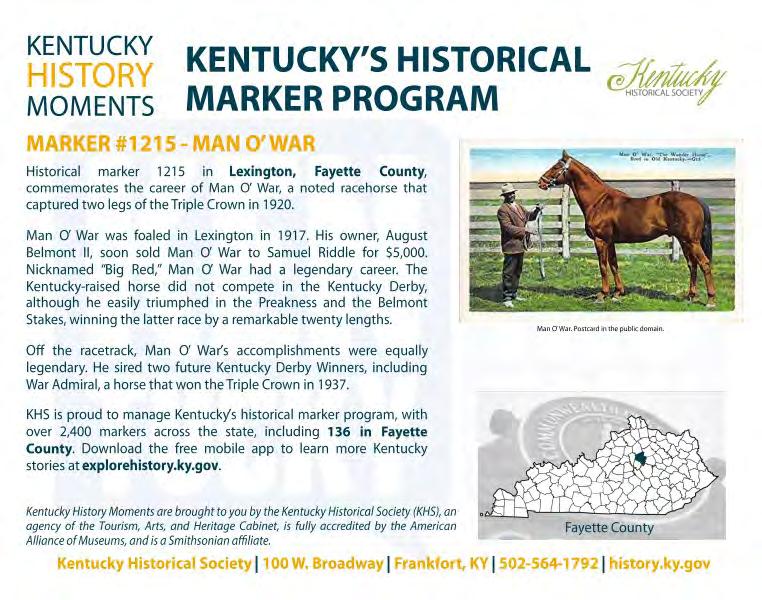
Reach 120,000 readers a classified ad in Kentucky Explorer! They are only $50 per issue (up to 25 words). Contact Deborah Kohl Kremer at deb@kentuckymonthly. com or call 888.329.0053.
BOOK FOR SALE — George Graham Vest: The Life and Times of Dog’s Best Friend chronicles the life and career of Frankfort native, jurist and legislator

George Graham Vest. The book is by Stephen M. Vest, a cousin, who also is known for his command of the English language. $26.95 plus shipping. To purchase, call 888.329.0053 or visit shopkentuckymonthly.com

BOOK FOR SALE — Reflections of a Scared Soldier Boy in Vietnam: God, Redlegs, and Blueboys by Robert Adams. The author’s combat tour with the First Air Cavalry Division, 859.806.5199. (A-A)
WANTED — Paying cash for large diamonds; collections of vintage wrist and pocket watches; gold and silver coins; sterling flatware and serving pieces; gold and silver jewelry; collections of arts and crafts and pottery; antique advertising signs; antique walking canes; pocket knives; collections of antique guns and swords;
military collections; early hand-crafted crocks and jugs; musical instruments; call Clarence, buyer for more than 35 years; 606.531 0467. (F-D)
KentuckyAntiqueTrail.com
Brochure/maps are in Kentucky state welcome centers, member stores, or contact info@AntiqueTrail.com or 256.797.5640
BACK ISSUES We have a select number of back issues of Kentucky Explorer from 1986-2000. Back issues are $5 plus shipping. If you are in search of a certain issue or are interested in adding an issue to your collection, please call 1.888 329 0053 or email kymonthly@kentuckymonthly.com to see if it’s available.
BY BILL ELLIS
When I grew up in the 1940s and ’50s on Snow Hill, just outside Shelbyville, I reflected the era in many ways.
I played “Cowboys and Indians” with playmates around houses, roadways and even in an old junkyard. When I was the smallest kid, the older ones always elected me to be the “Indian,” who ended up being killed (“playlike,” as we always called it) at the end of our skirmishes.
How could we have reacted otherwise after seeing Saturday movies at the old Burley Theater on Main Street starring Roy Rogers, Gene Autry, Sunset Carson and Wild Bill Elliott? The Native chief, usually played by a white Hollywood actor, always succumbed to the wiles of the white cowboys and cavalrymen.
My generation of white kids got little, if any, education about the real world of Native Americans. We had no instruction in school, with little on the radio or television through the 1950s.
That began to change but slowly. What I don’t know about Native Americans would fill a large library over and over again, but here is what I do know.
Early in my teaching career, I got a real education from many of my students, including the few Native Americans who found their way into my American history survey classes.
Two books—M. Scott Momaday’s House Made of Dawn (1966) and Dee Brown’s Bury My Heart at Wounded Knee
(1970)—changed how many Americans, even late-reader Bill Ellis, thought about the role of Native Americans in the “American Drama.” I say the latter because in this country, we Americans have always been either at war with ourselves or with others, it seems—in a cultural war if not a real bloody confrontation.
As kids, we learned that Native Americans never stayed long in Kentucky. They fought and hunted here and named it “Dark and Bloody Ground.” Right?
We kids roamed the fields of Shelby County and occasionally found pieces of flint and sometimes real arrowheads and stone pieces. Do kids today still have the freedom to roam as we did?
The expert on Kentucky placenames, Robert M. Rennick, and others have long declared the name for Kentucky as “dark and bloody ground” is not found in any known Native American language. On pages 725-726 of The Kentucky Encyclopedia, Rennick explained, “There has been no confirmation of several possible explanations. The precise meaning of the state’s name is unknown.” Perhaps “a Wyandot name meaning ‘land of tomorrow’: a generalized Algonquin term referring to a river bottom (kin/ athiki); a Shawnee word signifying the head of a river; an Iroquoian name meaning ‘place of meadows’. ”
Furthermore, “the folk etymology that sees the name Kentucky as the combination of ‘cane’ and ‘turkey’ has no credence,” Rennick maintained. But what about Helechawa in
Wolfe County? Rennick explained that the often alleged Native American name “is in fact an acronym—a not uncommon form on naming—for the name of Helen Chase Walbridge, the daughter of the man who brought one of the first railroads to eastern Kentucky.”
Some in our reading audience may recall this joke I heard years ago. A drunk got off the train in Helechawa. He read a sign as “Hell Each Way” and got back on the train.
Please do not foster on your children, grandchildren, and kith and kin that Kentucky’s name means in some unknown Native American tongue Dark and Bloody Ground, although if you watch the evening news, it possibly rings true. •
Native Americans lived on ancient Kentucky soil, as attested to by the remains of a large village in Clark County, Eskippakithiki, “place of blue licks.” If you have use of the internet, please look up something about “Adena, the Mound Builders” for more information. You might be astonished.
My University of Kentucky mentor, Richard Lowitt, later joined the University of Oklahoma faculty and wrote Twentieth-Century Oklahoma: Reflections on the Forty-Sixth State (2016) in which he described the fate of the Native Americans in that state, which became the homeland of many tribes, at least for a time.
A recent Ken Burns miniseries, The American Buffalo, followed the destruction of the Plains Native
American way of life in agonizing detail by the near-extinction of the animal.
I am an avid fan of the Tony Hillerman novels about Navajo policemen Joe Leaphorn and Jim Chee. The television adaptation, Skinwalkers: The Navajo Mysteries, starring Wes Studi and Adam Beach, was outstanding. The continuation by Hillerman’s daughter Anne of the Navajo mysteries is still quite good.
I hope my article will encourage majority white Anglo-Saxon Americans to learn more about the lives of Native Americans. I recently read that Native American, Native Alaskan and Native Hawaiian people make up about 3 percent of the United States population but are terribly underrepresented as elected officials.
A friend of mine, Mitch Randall, the chief executive officer of the moderate Baptist publication Good Faith Media, is proud of his Native American heritage, Muscogee Creek,
and his name, Numukutsu (Buffalo). “There was nothing warmer on a cold December day than the embrace of my maternal grandmother as she greeted me just days before Christmas,” he recalled in a recent article. “She wrapped her brown hands around me with the love only a grandmother can muster. Gigi made Christmas extra special every year. Okema Randall was my grandmother from Broken Arrow, Oklahoma.”
Randall goes on to explain that “as a child, she was a worldchampion ‘fancy dancer.’ ” As an adult, she served on the “Muscogee [Creek] educational council, emphasizing the importance of academic advancement of tribal members. She cared deeply for the next generation of Muscogee [Creeks].” What wonderful memories he has.


We need to see more news features such as on NBC Nightly News on Nov. 30, 2024. It was an announcement from the Comanche Nation News that a teacher, Katherine Boyd-Batstone, had completed her B.A. in teaching, an interview called “inspiring a new generation.”
If you can, read “The Lakota and the Legacy of Blue Water” in the November 2024 issue of Smithsonian magazine about the massacre of a Lakota community in Nebraska. The return of artifacts to the tribe is of utmost importance today.
Movies and television presentations of Native Americans have gotten much more realistic and even sympathetic to so many people and tribes who lost their land and even their artifacts to collectors and museums.
Readers may contact Bill Ellis at editor@ kentuckymonthly.com.




BY WALT REICHERT

Along with tulips and daffodils, iris is one of the signature flowers of spring in Kentucky. But while daffodils and tulips can rear their flower heads during the cold, rainy, sometimes snowy, not-quitedone-with-winter spring, the iris comes along when spring is more settled, and … well … springlike.
When most people think of iris, they picture the fuzzy bearded German iris. We called them flags back in the day, and they appeared in mid- to late April and bloomed through May. But the iris family is much more than the German iris, and getting to know some of the other family members means you can have iris blooming in your garden from late March through mid-June or later.
While most of the cultivated iris are imports from other parts of the world, we have a couple of natives worth a look. One is the crested iris (iris cristata), a dwarf iris native to woodlands in the Eastern and Southeastern United States. It tolerates dry shade, but as a wildflower, it can be difficult to find in commerce, and its flowers are
pretty but small and ephemeral.
Another native is the blue flag iris (iris versicolor). This one is a tall, rangy plant that likes to grow in swampy spots. Its purple flowers with white falls are striking but not heavily borne. It is a great plant for potting and sinking into a water feature. But beware that all parts of blue flag iris are poisonous if ingested.
While the above species are not common in home gardens, the following iris add a burst of unrivaled color to any bed or border. They are listed in order of bloom time, from the Dutch iris coming on in late March and blooming through early April to the Japanese iris blooming in late May through June.
Dutch iris—The Dutch iris (iris hollandica) is often caught by snow, which it ignores with grace and vigor. The orchid-like blossoms in colors of blue, purple, white and yellow are seemingly delicate, but the stems are hardy and hold up well as a cut flower. Dutch iris is the most popular among florists for that reason. The grass-like
stems grow up to 2 feet and bear a single flower. Dutch iris likes full sun. Unlike other iris that grow from rhizomes, Dutch iris grow from bulbs planted in the fall. Plant bulbs about 2 inches deep in well-drained soil.
German bearded iris—The most hybridized of the iris family, the German bearded iris (iris germanica) comes in a range of colors from almost black through purple, violet, red, yellow, pink and white and hundreds of color combinations. German bearded iris blooms in mid-April through May. Reblooming varieties have been developed that flower in late summer or early fall. Like Dutch iris, German iris needs well-drained soil and full sun. Its rhizomes are planted in late summer and should be planted “like a duck on water”—its roots in soil but the top of the rhizome sticking just above ground.
Siberian iris—Blooming just after the German iris, Siberian iris, for many, is easier to accommodate in the bed and border because its leaves are a more even green and less intrusive than the pale, strap-like leaves of German iris. Siberian iris likes full sun but is more adaptable to part shade than German or Dutch iris. It tolerates wet spots, though it can handle dry soil well, too. ‘Caesars brother’ is a popular purple variety. ‘Butter and sugar’ blooms yellow and white, while ‘Golden edge’ is a deep purple with striking golden veins.
Louisiana iris—Less common than the first three iris, Louisiana iris is actually the name for five species of iris native to Louisiana and the Mississippi delta. Though native to the Deep South, Louisiana iris will
grow from Zone 9 up through Zone 5. Like Siberian iris, Louisiana iris tolerates (actually prefers) moist soils. Its purple orchid-like blooms come in late spring. ‘Black gamecock’ is probably the most common variety.
Japanese iris—Sporting the largest blooms of any iris—up to 6 inches across—the Japanese iris (iris ensata) blooms in early to mid-summer. The grass-like leaves of Japanese iris grow 3-4 feet, and the plant tolerates wet soil. In fact, it will grow in or at the water’s edge. ‘Royal Robes’ is a deep purple and yellow variety. ‘Ice Cream’ is a light purple edged in white, while ‘Tiramisu’ is a striking white spotted with purple and edged in a light purple.
All iris benefit from digging and dividing every three to five years. You will know it’s time for that chore when the blooms start to get sparse. Use a stout shovel or garden fork to dig up the entire planting, break the clump apart, and set the rhizomes (or bulbs) back in place. Remove any rhizomes that show signs of insect damage or disease (especially German bearded) and start a new bed with the leftovers or give them away.
Many gardeners give up on iris because the clumps of rhizomes can get infested with grasses, especially Bermuda grass. Short of digging them up and starting a new bed, you might try spraying with a chemical containing sethoxydim that will kill the grass but not the iris. The products often are sold as “Grass Beater” or “Grass B Gone.” Note that these products will kill grassy weeds but not broadleaf weeds. Otherwise, the iris family is one of the easiest-to-care-for plants in the flower garden.
Readers may contact Walt Reichert at editor@kentuckymonthly.com





17






































BY GARY GARTH

April. It’s everyone’s favorite month, aside from those of us who are equally fond of October. The weather, in general, has tempered and steadied but not yet obtained the sauna-like layering of heat and moisture that’s coming.
Hiking trails are open, campgrounds are uncrowded, grass is green, forests are leafy, turkeys are gobbling, and crappie are spawning. What’s not to love?
• • •
Let’s start with turkeys.
Turkeys are interesting critters— beautiful in their own way with a layering of iridescent feather coloring that can shift from bronze to green within a single shaft of light and a head that blends reds, blues and grays and harbors a walnut-size brain. The birds’ vision is astounding, as any hunter can attest.
Turkeys in Kentucky are a conservation success story almost without equal. Once, they were plentiful in every corner of the Commonwealth. Then, early in the last century, numbers began to decline. Reasons vary, but the main culprit was habitat loss. Numbers shrank to around 2,000 birds statewide. Conservation efforts were put in place. Habitats improved. Birds
responded. Hunting opportunities expanded.
Turkeys are now found statewide. The spring turkey hunting season is set to roughly coincide with the birds’ spring breeding season, which generally peaks in mid- to late April. Gobblers looking for a mate can occasionally be distracted by a hunter who knows how to use a turkey call.
State wildlife officials long ago decided that the spring season would begin on the Saturday in April closest to April 15. This year, that date is April 12. The season will run for 23 consecutive days, closing May 4.
Last year, Kentucky hunters checked 33,465 turkeys, a healthy number, during the spring season. Logan County surrendered the most with 537, but hunters in Muhlenberg County scored a close second, checking 525 birds. For many years, the spring hunt was limited to male birds (gobblers). Hens were off limits. In the field, this designation is made by the presence of a bird’s beard, which is neither hair nor feathers but a keratinous-type filament. But occasionally, a hunter would bag a bird sporting a small beard only to discover it was a hen, leaving the legal status of an otherwise legal hunter in limbo. Game officials finally erased this occasional-but-thorny conflict by
tweaking the regulations and making a legal bird “any bearded turkey.” Of the 34,465 birds checked last year, 233 were bearded hens.
If a turkey beard has any purpose other than helping a gobbler attract a mate, the folks who study turkeys don’t know what it is.
• • •
Unlike turkeys, crappie—arguably the most popular panfish in Kentucky and probably the United States—are not limited to a season. Anglers can catch them whenever they can find them.
Kentucky’s unofficial peak crappie season is April. That’s because as water temperatures warm into the high 50s and low 60s, the tasty panfish move from deep water wintering confines to shallow water to spawn. They’re easy to find and generally easy to catch. Water temperatures in the 62- to 68-degree range generally are considered optimal for crappie to spawn. If you’re fishing an area that’s home to white and black crappie (such as Kentucky Lake and Lake Barkley), black crappie generally spawn earlier and slightly deeper than their white cousins. Water temperature, along with weather and water levels combine to drive the spawn. Generally, the peak of the spawn runs about 7-10 days, sometimes longer. Don’t miss it.
• • •
A word of caution and advice for those planning an excursion: The Trump administration’s Department of Government Efficiency (DOGE), created by an executive order and headed by Elon Musk—who was appointed and not elected—has been busy eliminating numerous federal programs and jobs, including some services that visitors to the nation’s parks and other recreation areas enjoy.
The order is a bit vague (you can read it at www.whitehouse.gov/ presidential-actions/2025/01/ establishing-and-implementing-thepresidents-department-ofgovernment-efficiency) but essentially is a directive to cut the federal government workforce under the pretense of saving money. Outside the military, no federal workforce appears immune to these seemingly random and careless cuts. Recreational areas—including national parks, national monuments, forests and public land use areas—seem particularly vulnerable, despite their popularity with the public.
Kentucky is home to several federal recreational use areas, including but not limited to Mammoth Cave National Park, Cumberland Gap National Historic Park, Clarks River

Wants to

Before planning a trip, particularly an extensive outing, call or do an online check of facility and service availability.

In 2024, Kentucky was home to more than 23,000 federal civilian jobs, many of which were filled by hardworking folks doing public service work for modest pay. I have no specifics on Kentucky cutbacks, except that you should expect some. If so, express any frustration to your political leaders, not the overworked, onsite personnel at the park, forest or campsite you’re trying to access. It’s not their fault.
Readers may contact Gary Garth at editor@kentuckymonthly.com




Branford Marsalis Quartet
EKU Center for the Arts, Richmond, 859.622.7469
Doggone Egg Hunt Old Mulkey Meetinghouse, Tompkinsville, 270.487.8481


Bill Gaither & The Gaither Vocal Band SKyPAC, Bowling Green, 270.904.1880






As you may remember from previous columns, I stand roughly 5-foot-8, as I have since I was a growth-spurt sixth grader.
That winter, I was a member of the undefeated Doss Optimist Celtics, a basketball team so well coached that we took on teams outside of our league. In one such game, I went up against a kid who was maybe a half-inch taller than I am. I felt inflated when I held him to less than 10 points when he’d been averaging 25. We won the game. When I learned later that he was 7 years old, I was deflated and felt like a bully.
He went on to be Kentucky’s Mr. Basketball and a highschool All-American.

STEPHEN M. VEST Publisher + Editor-in-Chief
Years later, I met him again and asked him if he remembered our encounter on the hardwood at Louisville’s Walnut Street Baptist Church. “Yeah,” he said after taking a long look at my face, “but I remember you being much taller.”
It’s all a matter of perspective.
Over the years, I’ve put together a few teams. I’ve always followed one simple rule: everyone I select must be better than I am (at something). When following this rule, it’s important to be self-aware, which I’ve always been. I know my weaknesses better than anyone. For example, I would never place myself on a track team.
Most of my teams, which extend beyond ballfields, have fared well—so well at times that I’ve left myself no place to play.
There is a vast difference between being the worst player on a team and recruiting a team where everyone is better than you. Again, it’s a matter of perspective. I was once asked by group of brilliant college kids to be on a four-person trivia team. “Why would you want me?” I asked.
“Because,” they said, “you know the stuff we don’t.”
I quickly saw what they meant. It’s the same as when I’m watching Jeopardy. Almost always, when none of the contestants know the answer, I do. If they all know it, I don’t. In questions 1, 2 and 3 at the trivia competition, not only did I not know the answers, but I also didn’t even understand the questions. All three of my teammates knew them and seemed astonished that I didn’t. “It’s elementary,” they said.
Question 4 asked for the name of Gatsby’s neighbor. “Well, duh,” I thought, but amazingly, none of them had a clue. “It’s Nick,” I said. “You know, ‘Old Sport,’ he lives in a cottage next to Gatsby’s mansion …”
“What’s a Gatsby?” they asked.
“Gatsby is a who—the protagonist in F. Scott Fitzgerald’s 1925 novel.”
This pattern continued. In questions 5, 6 and 7, I was clueless.
Question 8 asked for the back-door computer password in the Matthew Broderick film War Games. My teammates’ blank faces showed they hadn’t a clue. “It’s Joshua,” I said. “It’s the name of the designer’s deceased son.”
So, a quarter of the time I was a genius and the rest of the time … pitiful. It’s all a matter of perspective.
While I don’t have details to share, the next Kentucky Monthly trip has been scheduled for June 2026. We’ll fly into Rome, board a ship to several Italian destinations, then stop at least twice along the French Riviera before ending our cruise in Barcelona, Spain. There will be optional land tours of Rome prior to the cruise and of Barcelona afterward.
Kentucky Monthly’s previous trips have all drawn between 75-90 travelers. We’ve visited the Caribbean, Ireland, Italy and Alaska.
Vest can be contacted at steve@kentuckymonthly.com


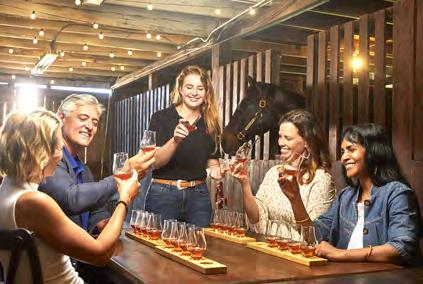

April & May – Big Bloom at Yew Dell Botanical Gardens April 19 – Blue Hydrangea Tea on Main Street
April 26 – Earth Day at Hermitage Farm with Kentucky’s Poet Laureate, Silas House

May 9 - 11 – La Grange RailFest 175 May 10 – Crestwood Art & Garden Market




